Two Epochs of Mineralization of Orogenic Gold Deposit in the East Kunlun Orogenic Belt: Constraints from Monazite U–Pb Age, In Situ Sulfide Trace Elements and Sulfur Isotopes in Wulonggou Gold Field
Abstract
:1. Introduction
2. Geological Setting
3. Ore Deposit Geology
Paragenetic Sequences
4. Analytical Method
4.1. Mineralogy
4.2. Monazite U–Pb Dating
4.3. In Situ Sulfide Trace Element Analysis and Mapping
4.4. In Situ Sulfide Sulfur Isotope Analysis
5. Results
5.1. In Situ U–Pb Geochronology of Monazite
5.2. Generation and Texture of Pyrite
5.3. Trace Element Distribution in Sulfide
5.3.1. Mapping of the Py1 and Py2 in the Hongqigou and Huanglonggou Deposits
5.3.2. In Situ Trace Element Analysis
5.4. Sulfur Isotopic Data on Sulfide
6. Discussion
6.1. Evolution of Pyrite Textures and Compositions
6.1.1. Mineral Paragenesis and Evolution
6.1.2. Relationship and Evolution of Trace Elements in Hongqigou and Huanglonggou Deposits
6.1.3. Source of Ore-Forming Materials
Hongqigou
Huanglonggou
6.2. Tectonic Evolution and Mineralization
6.3. Magmatism and Mineralization
7. Conclusions
- (1)
- The monazite U–Pb ages of the Huanglonggou and Hongqigou deposits were 422.2 ± 2.4 Ma (MSWD = 0.16) and 236.7 ± 3.7 Ma (MSWD = 0.33), suggesting that there two epochs of metallogenic events that occured in the WGF.
- (2)
- The ore-forming process can be divided into four hydrothermal stages: a quartz–pyrite stage (stage 1), a quartz–pyrite–arsenopyrite–chalcopyrite stage (stage 2), a quartz–galena–sphalerite–pyrite ± arsenopyrite ± chalcopyrite stage (stage 3) and a quartz–stibnite–carbonate stage (stage 4).
- (3)
- Stages 1 and 2 are the main gold mineralization stages, wherein Au and As have a close genetic relationship. The Hongqigou and Huanglonggou deposits seem to be formed in different metallogenic events due to the contrast on the trace element compositions in pyrite.
- (4)
- The source of ore-forming materials and fluids represented by δ34S and Co/Ni and Au/As ratios indicate that the Hongqigou and Huanglonggou deposits have apparent characteristics of orogenic gold deposit, and magmatic events happened during Paleozoic and Mesozoic made crucial contribution to their mineralization.
- (5)
- We propose that the WGF went through multiple-complex metallogenic processes based on multi-proxy studies, and that this can be interpreted as an orogenic gold field related to multiple tectonic–magmatic events.
Author Contributions
Funding
Institutional Review Board Statement
Informed Consent Statement
Data Availability Statement
Acknowledgments
Conflicts of Interest
Appendix A
| Sample | 59Co | 60Ni | 65Cu | 66Zn | 75As | 107Ag | 121Sb | 125Te | 197Au | 208Pb | 209Bi |
|---|---|---|---|---|---|---|---|---|---|---|---|
| Schist-Po-1 | 459.535 | 884.485 | 0.361 | 1.137 | 2.448 | 1.104 | 0.733 | 0.000 | 0.054 | 0.579 | 1.632 |
| Schist-Po-2 | 491.131 | 1073.904 | 0.530 | 4.328 | 3.875 | 2.134 | 7.881 | 0.000 | 0.000 | 6.416 | 12.138 |
| Schist-Po-3 | 436.918 | 746.358 | 0.228 | 1.853 | 0.000 | 1.977 | 0.284 | 0.461 | 0.084 | 1.560 | 2.543 |
| Schist-Po-4 | 461.758 | 753.520 | 0.000 | 0.000 | 0.000 | 0.000 | 0.421 | 0.000 | 0.033 | 1.100 | 2.688 |
| Schist-Po-5 | 433.093 | 832.637 | 1.453 | 7.117 | 2.040 | 2.240 | 5.391 | 0.000 | 0.000 | 8.720 | 13.182 |
| Schist-Po-6 | 462.730 | 851.527 | 0.801 | 2.995 | 1.587 | 0.000 | 0.178 | 0.157 | 0.021 | 0.155 | 0.367 |
| Schist-Po-7 | 326.323 | 591.205 | 1.949 | 5.291 | 4.594 | 0.000 | 15.199 | 0.000 | 0.124 | 3.610 | 2.674 |
| Schist-Po-8 | 382.343 | 769.667 | 0.863 | 0.000 | 0.000 | 1.288 | 4.613 | 0.000 | 0.101 | 2.410 | 1.814 |
| Ultramylonite-Py-1 | 989.711 | 158.880 | 29.096 | 3.412 | 1648.837 | 18.771 | 0.000 | 170.268 | 2.841 | 0.151 | 25.861 |
| Ultramylonite-Py-2 | 73.199 | 66.455 | 43.764 | 3.898 | 6515.266 | 2.583 | 3.657 | 145.199 | 0.686 | 0.512 | 55.638 |
| Ultramylonite-Py-3 | 239.699 | 1027.331 | 1290.252 | 8.683 | 456.654 | 10.258 | 2.022 | 161.739 | 0.000 | 0.020 | 23.681 |
| Ultramylonite-Py-4 | 778.476 | 1663.032 | 54.432 | 7.999 | 1829.331 | 3.779 | 1.443 | 115.420 | 0.000 | 0.175 | 40.664 |
| Ultramylonite-Py-5 | 2090.737 | 345.773 | 2124.885 | 2.923 | 534.603 | 2.355 | 3.283 | 192.794 | 0.248 | 0.096 | 46.837 |
| Ultramylonite-Py-6 | 2045.162 | 798.940 | 753.049 | 5.934 | 455.063 | 3.733 | 2.382 | 196.658 | 0.000 | 0.029 | 49.249 |
| Ultramylonite-Py-7 | 887.432 | 439.957 | 115.751 | 6.230 | 648.894 | 7.784 | 1.845 | 114.985 | 0.176 | 0.118 | 29.197 |
| Ultramylonite-Py-8 | 298.831 | 30.788 | 25.344 | 0.937 | 6884.256 | 4.868 | 0.000 | 145.684 | 0.000 | 0.000 | 110.829 |
| Hongqigou-Py1-1 | 32.496 | 55.501 | 256.376 | 1.585 | 34,711.167 | 1.453 | 196.130 | 0.000 | 1.545 | 46.914 | 0.102 |
| Hongqigou-Py1-2 | 23.159 | 33.234 | 119.957 | 1.886 | 21,440.451 | 0.974 | 224.104 | 0.000 | 1.200 | 72.416 | 0.089 |
| Hongqigou-Py1-3 | 44.046 | 56.473 | 200.034 | 0.000 | 31,916.973 | 0.000 | 313.303 | 2.123 | 1.684 | 86.845 | 0.253 |
| Hongqigou-Py1-4 | 55.921 | 103.544 | 142.710 | 3.328 | 25,950.584 | 2.491 | 480.888 | 1.614 | 1.691 | 148.769 | 0.256 |
| Hongqigou-Py1-5 | 23.500 | 27.524 | 360.547 | 2.609 | 56,807.293 | 0.000 | 113.957 | 0.000 | 1.115 | 23.523 | 0.136 |
| Hongqigou-Py1-6 | 25.818 | 25.736 | 324.491 | 0.000 | 44,347.997 | 1.107 | 80.295 | 0.000 | 0.790 | 17.017 | 0.084 |
| Hongqigou-Py2-1 | 84.478 | 162.908 | 504.067 | 0.000 | 57,046.708 | 0.000 | 64.167 | 0.000 | 0.668 | 16.123 | 0.305 |
| Hongqigou-Py2-2 | 107.331 | 175.986 | 185.494 | 12.144 | 40,115.177 | 0.000 | 491.204 | 1.869 | 1.500 | 121.852 | 0.408 |
| Hongqigou-Py2-3 | 159.267 | 242.640 | 366.549 | 2.229 | 50,364.569 | 3.160 | 243.525 | 0.000 | 0.263 | 74.326 | 0.621 |
| Hongqigou-Py2-4 | 157.768 | 240.426 | 372.535 | 146.296 | 49,913.188 | 5.901 | 373.624 | 1.508 | 0.722 | 89.542 | 0.620 |
| Hongqigou-Py2-5 | 73.299 | 102.625 | 483.004 | 0.000 | 76,993.084 | 0.000 | 138.039 | 0.000 | 0.616 | 29.056 | 0.306 |
| Hongqigou-Py2-6 | 62.817 | 108.774 | 463.063 | 0.000 | 44,662.812 | 1.430 | 120.927 | 0.000 | 0.682 | 36.612 | 0.471 |
| Hongqigou-Py2-7 | 81.504 | 204.076 | 607.798 | 0.000 | 57,651.922 | 1.140 | 51.747 | 0.000 | 0.606 | 10.809 | 0.068 |
| Hongqigou-Py2-8 | 61.228 | 102.925 | 301.078 | 0.000 | 46,622.748 | 0.000 | 177.871 | 0.000 | 0.972 | 39.262 | 0.296 |
| Hongqigou-Py2-9 | 57.332 | 121.853 | 589.064 | 0.000 | 67,080.552 | 1.399 | 135.813 | 0.000 | 3.447 | 25.224 | 0.203 |
| Hongqigou-Py2-10 | 62.537 | 113.939 | 365.369 | 2.128 | 52,337.898 | 0.000 | 101.625 | 0.000 | 0.748 | 22.524 | 0.287 |
| Hongqigou-Py3-1 | 0.372 | 5.640 | 4.065 | 3.334 | 3909.772 | 9.880 | 265.700 | 3.257 | 0.311 | 245.648 | 13.984 |
| Hongqigou-Py3-2 | 32.846 | 21.510 | 0.737 | 0.000 | 3648.123 | 0.000 | 1.632 | 0.000 | 0.000 | 3.974 | 0.638 |
| Hongqigou-Py3-3 | 46.389 | 19.667 | 1.367 | 0.000 | 4124.308 | 0.000 | 7.310 | 0.000 | 0.248 | 26.473 | 2.498 |
| Hongqigou-Py3-4 | 0.036 | 0.000 | 1.285 | 0.000 | 2262.859 | 0.000 | 1.660 | 0.000 | 0.122 | 10.309 | 1.213 |
| Hongqigou-Py3-5 | 0.115 | 0.000 | 0.747 | 0.000 | 2366.442 | 0.000 | 17.782 | 1.991 | 0.107 | 20.720 | 1.385 |
| Hongqigou-Py3-6 | 0.088 | 0.000 | 2.524 | 1.517 | 5223.606 | 0.000 | 1.894 | 0.885 | 0.074 | 10.127 | 1.371 |
| Hongqigou-Py3-7 | 0.286 | 0.000 | 0.985 | 0.000 | 3146.679 | 0.000 | 4.424 | 2.242 | 0.000 | 12.141 | 0.922 |
| Hongqigou-Py3-8 | 10.640 | 17.532 | 15.724 | 3.974 | 2892.840 | 8.928 | 130.690 | 8.308 | 0.751 | 857.226 | 35.190 |
| Hongqigou-Py3-9 | 6.045 | 3.601 | 3.910 | 0.000 | 2693.539 | 5.868 | 61.061 | 1.593 | 0.378 | 71.816 | 5.536 |
| Huanglonggou-Py1-1 | 26.486 | 119.034 | 10.330 | 8.918 | 4662.131 | 0.000 | 0.000 | 99.793 | 1.071 | 0.454 | 60.713 |
| Huanglonggou-Py1-2 | 53.938 | 16.091 | 37.423 | 5.330 | 2588.104 | 30.761 | 0.000 | 206.446 | 0.000 | 0.541 | 433.007 |
| Huanglonggou-Py1-3 | 159.548 | 80.122 | 45.515 | 4.152 | 671.534 | 23.903 | 6.375 | 429.231 | 0.000 | 0.801 | 548.332 |
| Huanglonggou-Py1-4 | 203.787 | 203.031 | 45.706 | 8.376 | 1233.971 | 17.891 | 7.261 | 390.036 | 0.445 | 0.755 | 761.660 |
| Huanglonggou-Py1-5 | 52.195 | 89.540 | 27.779 | 6.579 | 732.027 | 14.941 | 2.718 | 220.313 | 0.000 | 0.568 | 420.303 |
| Huanglonggou-Py1-6 | 14.371 | 58.264 | 16.535 | 0.000 | 6985.995 | 14.681 | 2.332 | 131.251 | 0.000 | 0.387 | 209.036 |
| Huanglonggou-Py1-7 | 39.947 | 152.367 | 74.903 | 0.000 | 8270.601 | 0.000 | 29.734 | 916.985 | 0.000 | 1.414 | 264.691 |
| Huanglonggou-Py1-8 | 152.760 | 313.391 | 86.059 | 2.255 | 5722.234 | 30.008 | 2.643 | 513.597 | 1.078 | 0.656 | 1210.961 |
| Huanglonggou-Py1-9 | 84.559 | 122.308 | 64.932 | 4.021 | 8871.994 | 29.542 | 0.000 | 419.968 | 2.416 | 0.000 | 972.028 |
| Huanglonggou-Py1-10 | 100.177 | 210.616 | 53.104 | 15.131 | 5297.483 | 47.119 | 1.799 | 333.662 | 0.000 | 0.342 | 800.335 |
| Huanglonggou-Py2-1 | 7.537 | 61.689 | 6.086 | 0.000 | 5498.355 | 0.000 | 0.000 | 56.931 | 0.000 | 0.456 | 32.160 |
| Huanglonggou-Py2-2 | 10.822 | 130.019 | 1.232 | 0.000 | 1575.172 | 0.000 | 0.000 | 10.803 | 0.000 | 0.143 | 4.263 |
| Huanglonggou-Py2-3 | 135.063 | 56.744 | 25.632 | 2.440 | 250.834 | 15.419 | 2.932 | 178.409 | 0.000 | 0.135 | 269.836 |
| Huanglonggou-Py2-4 | 1.646 | 39.854 | 12.457 | 0.000 | 2074.031 | 7.609 | 1.236 | 120.581 | 0.724 | 1.153 | 156.222 |
| Huanglonggou-Py2-5 | 0.707 | 4.625 | 46.142 | 79.576 | 2193.181 | 4.008 | 11.649 | 460.266 | 1.229 | 0.000 | 76.231 |
| Huanglonggou-Py2-6 | 43.340 | 147.200 | 54.534 | 7.673 | 13,275.196 | 19.131 | 7.322 | 348.155 | 0.000 | 0.592 | 167.483 |
| Huanglonggou-Py2-7 | 1.268 | 8.446 | 5.126 | 1.594 | 4423.075 | 0.000 | 1.499 | 30.208 | 0.000 | 0.202 | 21.976 |
| Huanglonggou-Py2-8 | 11.419 | 16.276 | 9.044 | 0.000 | 5415.672 | 5.730 | 0.000 | 17.236 | 0.527 | 0.271 | 32.765 |
| Huanglonggou-Py3-1 | 8.533 | 4.247 | 9.788 | 5.692 | 3831.076 | 10.351 | 2.099 | 7.733 | 0.000 | 0.981 | 46.958 |
| Huanglonggou-Py3-2 | 8.410 | 4.355 | 7.730 | 0.000 | 6464.305 | 11.060 | 3.567 | 20.651 | 0.000 | 2.423 | 503.080 |
| Huanglonggou-Py3-3 | 7.393 | 10.818 | 6.513 | 2.156 | 3557.323 | 5.192 | 11.823 | 19.107 | 1.418 | 1.619 | 1853.086 |
| Huanglonggou-Py3-4 | 12.274 | 2.107 | 2.553 | 0.000 | 11,409.009 | 9.809 | 0.000 | 3.573 | 0.000 | 4.018 | 15.335 |
| Huanglonggou-Py3-5 | 27.731 | 56.888 | 14.968 | 0.000 | 8494.598 | 11.715 | 8.356 | 42.921 | 0.000 | 0.593 | 800.227 |
| Huanglonggou-Py3-6 | 12.369 | 69.971 | 4.023 | 0.000 | 2636.416 | 8.345 | 0.000 | 8.120 | 0.000 | 0.238 | 46.526 |
| Huanglonggou-Py3-7 | 7.310 | 18.067 | 2.135 | 0.000 | 612.995 | 11.731 | 0.000 | 9.519 | 0.000 | 0.128 | 17.815 |
| Huanglonggou-Py3-8 | 11.240 | 5.630 | 5.456 | 2.840 | 9759.127 | 13.659 | 0.000 | 5.119 | 2.615 | 4.304 | 36.514 |
| Huanglonggou-Py3-9 | 11.437 | 3.475 | 11.761 | 0.000 | 3335.870 | 0.000 | 5.096 | 28.996 | 1.354 | 1.118 | 754.925 |
References
- Zhang, J.Y.; Ma, C.Q.; Li, J.W. Visible gold-forming environment evidenced by sulfide mineralogical characteristics of Shuizhadonggou-Huanglonggou gold deposit in eastern Kunlun orogen. Miner. Depos. 2012, 31, 1184–1194, (In Chinese with English abstract). [Google Scholar]
- Zhang, J.Y.; Ma, C.Q.; Li, J.W.; Pan, Y.M. A possible genetic relationship between orogenic gold mineralization and post-collisional magmatism in the eastern Kunlun Orogen, western China. Ore Geol. Rev. 2017, 81, 342–357. [Google Scholar] [CrossRef]
- Zhang, Y.T. Research on Metallogenesis of Gold Deposits in the Wulonggou Ore Concentration Area, Central Segment of the East Kunlun Mountains, Qinghai Province; Jilin University: Changchun, China, 2018; (In Chinese with English abstract). [Google Scholar]
- Chen, B.L.; Wang, Y.; Han, Y.; Chen, J.L. Metallogenic age of Yanjingou gold deposit in Wulonggou gold orefield, eastern Kunlun Mountains. Miner. Depos. 2019, 38, 541–556, (In Chinese with English abstract). [Google Scholar]
- Chen, J.J.; Wei, J.H.; Fu, L.B.; Li, H.; Zhou, H.Z.; Zhao, X.; Zhan, X.F.; Tan, J. Multiple sources of the Early Mesozoic Gouli batholith, Eastern Kunlun Orogenic Belt, northern Tibetan Plateau: Linking continental crustal growth with oceanic subduction. Lithos 2018, 292–293, 161–178. [Google Scholar] [CrossRef] [Green Version]
- Qinghai Bureau of Geology and Mineral Resources (QBGMR). Regional Geology of Qinghai Province; Geological Publishing House: Beijing, China, 1991; pp. 1–662, (In Chinese with English abstract). [Google Scholar]
- Jiang, C.F.; Yang, J.S.; Feng, B.G.; Zhu, Z.Z.; Zhao, M. Opening-Closing Tectonics of the Kunlun Mountalns; Geological Publishing House: Beijing, China, 1992; pp. 1–224, (In Chinese with English abstract). [Google Scholar]
- Chen, N.S.; Wang, Q.Y.; Chen, Q.; Li, X.Y. Components and metamorphism of the basements of the Qaidam and Oulongbuluke micro-continental blocks, and a tentative interpretation of paleocontinental evolution in NW-Central China. Earth Sci. Front. 2007, 14, 43–55, (In Chinese with English abstract). [Google Scholar]
- Ding, Q.F.; Yan, W.; Zhang, B.L. Sulfur-and lead-isotope geochemistry of the Balugou Cu-Pb-Zn skarn deposit in the Wulonggou area in the eastern Kunlun Orogen, NW China. J. Earth Sci. 2016, 27, 740–750. [Google Scholar] [CrossRef]
- Chen, N.S.; Li, X.Y.; Zhang, K.X.; Wang, G.C.; Zhu, Y.H.; Hou, G.J.; Bai, Y.S. Lithological characteristics of the Baishahe formation to the south of Xiangride Town, Eastern Kunlun Mountains and its age constrained from zircon Pb–Pb dating. Bull. Geol. Sci. Technol. 2006, 25, 1–7, (In Chinese with English abstract). [Google Scholar]
- Zhang, J.X.; Wan, Y.S.; Meng, F.C.; Yang, J.S.; Xu, Z.Q. Geochemistry, Sm-Nd and U-Pb isotope study of gneisses (schists) enclosing eclogites in the North Qaidam Mountains-deeply subducted Precambrian metamorphic basement? Acta Petrol. Sin. 2003, 19, 443–451, (In Chinese with English abstract). [Google Scholar]
- Wang, G.C.; Wang, Q.H.; Jian, P.; Zhu, Y.H. Zircon SHRIMP ages of Precambrian metamorphic basement rocks and their tectonic significance in the eastern Kunlun Mountains, Qinghai Province, China. Earth Sci. Front. 2004, 11, 481–490, (In Chinese with English abstract). [Google Scholar]
- Liu, Y.J.; Genser, J.; Neubauer, F.; Jin, W.; Ge, X.H.; Handler, R.; Takasu, A. 40Ar/39Ar mineral ages from basement rocks in the Eastern Kunlun Mountains, NW China, and their tectonic implications. Tectonophysics 2005, 398, 199–224. [Google Scholar] [CrossRef]
- Meng, F.C.; Zhang, J.X.; Cu, M.H. Discovery of Early Paleozoic eclogite from the East Kunlun, Western China and its tectonic significance. Gondwana Res. 2013, 23, 825–836. [Google Scholar] [CrossRef]
- Mo, X.X.; Luo, Z.H.; Deng, J.F.; Yu, X.H.; Liu, C.D.; Shen, H.W.; Yuan, W.M.; Liu, Y.H. Granitoids and crust growth in East-Kunlun Orogenic Belt. Geol. J. China Univ. 2007, 13, 403–414, (In Chinese with English abstract). [Google Scholar]
- Zhang, B.W. Study on Metalliferous Deposits Mineralization in Southern Qilian Orogenic Belt, Qinghai Province; Jilin University: Changchun, China, 2010; (In Chinese with English abstract). [Google Scholar]
- Yang, J.S.; Robinson, P.T.; Jiang, C.F.; Xu, Z.Q. Ophiolites of the Kunlun mountains, China and their tectonic implications. Tectonophysics 1996, 258, 215–231. [Google Scholar] [CrossRef]
- Li, R.B.; Pei, X.Z.; Li, Z.C.; Liu, Z.Q.; Chen, G.C.; Chen, Y.X.; Wei, F.H.; Gao, J.M.; Liu, C.J.; Pei, L. Geological characteristics of Late Palaeozoic–Mesozoic unconformities and their response to some significant tectonic events in eastern part of Eastern Kunlun. Earth Sci. Front. 2012, 19, 244–254, (In Chinese with English abstract). [Google Scholar]
- Li, X.W.; Huang, X.F.; Luo, M.F.; Dong, G.C.; Mo, X.X. Petrogenesis and geodynamic implications of the Mid-Triassic lavas from East Kunlun, northern Tibetan Plateau. J. Asian Earth Sci. 2015, 105, 32–47. [Google Scholar] [CrossRef]
- Zhu, Y.H.; Pan, Y.M.; Zhang, K.X.; Chen, N.S.; Wang, G.C.; Hou, G.J. Mineralogical characteristics and petrogenesis of ophiolites in East Kunlun Orogenic Belt, Qinghai Province. Acta Mineral. Sin. 2000, 20, 128–142, (In Chinese with English abstract). [Google Scholar]
- Bian, Q.T.; Li, D.H.; Pospelov, I.; Yin, L.M.; Li, H.S.; Zhao, D.S.; Chang, C.F.; Luo, X.Q.; Gao, S.L.; Astrakhantsev, O.; et al. Age, geochemistry and tectonic setting of Buqingshan ophiolites, North Qinghai-Tibet Plateau, China. J. Asian Earth Sci. 2004, 23, 577–596. [Google Scholar] [CrossRef]
- Li, R.B.; Pei, X.Z.; Li, Z.C.; Sun, Y.; Feng, J.Y.; Lei, P.; Chen, G.C.; Liu, C.J.; Chen, Y.X. Geochemical features, age, and tectonic significance of the Kekekete mafic-ultramafic rocks, East Kunlun Orogen, China. Acta Geol. Sin. 2013, 87, 1319–1333. [Google Scholar]
- Wei, B. Study on the Geological Characteristic and Tectonic Attribute of the Ophiolite and Island-Arc-Type Igneous Rocks, Central Belt of East Kunlun (Eastern Section); Chang’an University: Xi’an, China, 2015; (In Chinese with English abstract). [Google Scholar]
- Qi, X.P.; Yang, J.; Fan, X.G.; Cui, J.T.; Cai, Z.F.; Zeng, X.W.; Wei, W.; Qu, X.X.; Zai, L.M. Age, geochemical characteristics and tectonic significance of Changshishan ophiolite in central East Kunlun tectonic mélange belt along the east section of East Kunlun Mountains. Geol. China 2016, 43, 797–816, (In Chinese with English abstract). [Google Scholar]
- Li, W.Y. Geochronology and Geochemistry of the Ophiolites and Island-Arc-Type Igneous Rocks in the Western Qinling Orogen and the Eastern Kunlun Orogen: Implication for the Evolution of the Tethyan Ocean; University of Science and Technology of China: Hefei, China, 2008; (In Chinese with English abstract). [Google Scholar]
- Liu, Z.Q.; Pei, X.Z.; Li, R.B.; Li, Z.C.; Zhang, X.F.; Liu, Z.G.; Chen, G.C.; Chen, Y.X.; Ding, S.P.; Guo, J.F. LA-ICP-MS zircon U-Pb geochronology of the two suites of ophiolites at the Buqingshan area of the A’nyemaqen Orogenic Belt in the southern margin of East Kunlun and its tectonic implication. Acta Geol. Sin. 2011, 85, 185–194, (In Chinese with English abstract). [Google Scholar]
- Chen, L.; Sun, Y.; Pei, X.Z.; Gao, M.; Feng, T. Northernmost paleo-tethyan oceanic basin in Tibet: Geochronological evidence from 40Ar/39Arage dating of Dur’ngoi ophiolite. Chin. Sci. Bull. 2001, 46, 1203–1205. [Google Scholar] [CrossRef]
- Yin, A.; Harrison, T.M. Geologic evolution of the Himalayan-Tibetan orogen. Annu. Rev. Earth Planet. Sci. 2000, 28, 211–280. [Google Scholar] [CrossRef] [Green Version]
- Roger, F.; Arnaud, N.; Gilder, S.; Tapponnier, P.; Jolivet, M.; Brunel, M.; Malavieille, J.; Xu, Z.Q.; Yang, J. Geochronological and geochemical constraints on Mesozoic suturing in east central Tibet. Tectonics 2003, 22, 1037. [Google Scholar] [CrossRef]
- Zhang, J.Y.; Ma, C.Q.; Xiong, F.H.; Liu, B.; Li, J.W.; Pan, Y.M. Early Paleozoic high- Mg diorite-granodiorite in the eastern Kunlun Orogen, western China: Response to continental collision and slab break-off. Lithos 2014, 210–211, 129–146. [Google Scholar] [CrossRef]
- Xiong, F.H.; Ma, C.Q.; Zhang, J.Y.; Liu, B.; Jiang, H.A. A reworking of old continental lithosphere: An important crustal evolutionmechanism in orogenic belts, as evidenced by Triassic I-type granitoids in the East Kunlun orogen, Northern Tibetan Plateau. J. Geol. Soc. 2014, 171, 847–863. [Google Scholar] [CrossRef]
- Xiong, F.H.; Ma, C.Q.; Wu, L.; Jiang, H.A.; Liu, B. Geochemistry, zircon U-Pb ages and Sr-Nd-Hf isotopes of an Ordovician appinitic pluton in the East Kunlun orogen: New evidence for Proto-Tethyan subduction. J. Asian Earth Sci. 2015, 111, 681–697. [Google Scholar] [CrossRef]
- Chen, X.H.; Gehrels, G.; Yin, A.; Zhou, Q.; Huang, P.H. Geochemical and Nd–Sr–Pb–O isotopic constrains on Permo–Triassic magmatism in eastern Qaidam Basin, northern Qinghai-Tibetan plateau: Implications for the evolution of the Paleo-Tethys. J. Asian Earth Sci. 2015, 114, 674–692. [Google Scholar] [CrossRef]
- Wu, C.; Yin, A.; Zuza, A.V.; Zhang, J.Y.; Liu, W.C.; Ding, L. Pre-Cenozoic geologic history of the central and northern Tibetan plateau and the role of Wilson cycles in constructing the Tethyan orogenic system. Lithosphere 2016, 8, 254–292. [Google Scholar] [CrossRef] [Green Version]
- Chen, N.S.; Zhang, L.; Sun, M.; Wang, Q.Y.; Kusky, T.M. U–Pb and Hf isotopic compositions of detrital zircons from the paragneisses of the Quanji Massif, NW China: Implications for its early tectonic evolutionary history. J. Asian Earth Sci. 2012, 54–55, 110–130. [Google Scholar] [CrossRef]
- Dai, J.G.; Wang, C.S.; Jeremy, H.; Santosh, M. Multi-stage tectono-magmatic events of the Eastern Kunlun Range, northern Tibet: Insights from U-Pb geochronology and (U-Th)/He thermochronology. Tectonophysics 2013, 599, 97–106. [Google Scholar] [CrossRef]
- Chen, Y.X.; Pei, X.Z.; Li, R.B.; Liu, Z.Q.; Li, Z.C.; Zhang, X.F.; Chen, G.C.; Liu, Z.G.; Ding, S.P.; Guo, J.F. Zircon U-Pb age of Xiaomiao Formation of Proterozoic in the Eastern section of the East Kunlun Orogenic Belt. Geoscience 2011, 25, 510–521, (In Chinese with English abstract). [Google Scholar]
- Yu, C. Characteristics of Metamorphic Rock Series and It’s Fluid Inclusions from Jinshuikou in Eastern Kunlun; Jilin University: Jilin, China, 2005; (In Chinese with English abstract). [Google Scholar]
- Lu, L. Study on the Ore-Controlling Structure of Wulonggou Gold Deposit in East Kunlun Mountain; Chinese Academy of Geological Sciences: Beijing, China, 2011; (In Chinese with English abstract). [Google Scholar]
- Liu, B.; Ma, C.Q.; Guo, P.; Zhang, J.Y.; Xiong, F.H.; Huang, J.; Jiang, H.A. Discovery of the middle Devonian A-type granite from the Eastern Kunlun Orogen and its tectonic implications. Earth Sci. J. China Univ. Geosci. 2013, 38, 947–962, (In Chinese with English abstract). [Google Scholar]
- Zhang, D.Q.; Feng, C.Y.; Li, D.X.; Xu, W.Y.; Yan, S.H. Orogenic gold deposits in the North Qaidam and East Kunlun Orogen, West China. Miner. Depos. 2001, 20, 137–146, (In Chinese with English abstract). [Google Scholar]
- Liu, Z.C.; Wu, F.Y.; Yang, Y.H.; Yang, J.H.; Wilde, S.A. Neodymium isotopic compositions of the standard monazites used in U-Th-Pb geochronology. Chem. Geol. 2012, 334, 221–239. [Google Scholar] [CrossRef]
- Griffin, W.; Powell, W.; Pearson, N.; O’Reilly, S. GLITTER: Data reduction software for laser ablation ICP-MS. Mineral. Assoc. Can. 2008, 40, 308–311. [Google Scholar]
- Danyushevsky, L.; Robinson, P.; Gilbert, S.; Norman, M.; Large, R.; McGoldrick, P.; Shelley, M. Routine quantitative multi-element analysis of sulphide minerals by laser ablation ICP-MS: Standard development and consideration of matrix effects. Geochem. Explor. Environ. Anal. 2011, 11, 51–60. [Google Scholar] [CrossRef]
- Fu, J.; Hu, Z.; Zhang, W.; Yang, L.; Liu, Y.; Li, M.; Zong, K.; Gao, S.; Hu, S. In situ sulfur isotopes (delta (34)S and delta (33)S) analyses in sulfides and elemental sulfur using high sensitivity cones combined with the addition of nitrogen by laser ablation MC-ICP-MS. Anal. Chim. Acta 2016, 911, 14–26. [Google Scholar] [CrossRef]
- Hu, Z.; Zhang, W.; Liu, Y.; Gao, S.; Li, M.; Zong, K.; Chen, H.; Hu, S. “Wave” signalsmoothing and mercury-removing device for laser ablation quadrupole and multiple collector ICPMS analysis: Application to lead isotope analysis. Anal. Chem. 2015, 87, 1152–1157. [Google Scholar] [CrossRef]
- Zhang, W.; Hu, Z.; Liu, Y. Iso-Compass: New freeware software for isotopic data reduction of LA-MC-ICP-MS. J. Anal. At. Spectrom. 2020, 35, 1087–1096. [Google Scholar] [CrossRef]
- Reich, M.; Kesler, S.E.; Utsunomiya, S.; Palenik, C.S.; Chryssoulis, S.L.; Ewing, R.C. Solubility of gold in arsenian pyrite. Geochim. Cosmochim. Acta 2005, 69, 2781–2796. [Google Scholar] [CrossRef]
- Barker, S.L.L.; Hickey, K.A.; Cline, J.S.; Dipple, G.M.; Kilburn, M.R.; Vaughan, J.R.; Longo, A.A. Uncloaking invisible gold: Use of nano-SIMS to evaluate gold, trace elements, and sulphur isotopes in pyrite from Carlin-type gold deposits. Econ. Geol. 2009, 104, 897–904. [Google Scholar] [CrossRef]
- Deditius, A.P.; Utsunomiya, S.; Ewing, R.C.; Chryssoulis, S.L.; Venter, D.; Kesler, S.E. Decoupled geochemical behavior of As and Cu in hydrothermal systems. Geology 2009, 37, 707–710. [Google Scholar] [CrossRef]
- Deditius, A.P.; Utsunomiya, S.; Kesler, S.E.; Reich, M.; Ewing, R.C. Trace elements nanoparticles in pyrite. Ore Geol. Rev. 2011, 42, 32–46. [Google Scholar] [CrossRef]
- Large, R.R.; Danyushevsky, L.; Hollit, C.; Maslennikov, V.; Meffre, S.; Gilbert, S.; Bull, S.; Scott, R.; Emsbo, P.; Thomas, H.V.; et al. Gold and trace element zonation in pyrite using a laser imaging technique: Implications for the timing of gold in orogenic and Carlin-Style sediment-hosted deposits. Econ. Geol. 2009, 104, 635–668. [Google Scholar] [CrossRef]
- Deditius, A.P.; Reich, M.; Kesler, S.E.; Utsunomiya, S.; Chryssoulis, S.L.; Walshe, J.; Ewing, R.C. The coupled geochemistry of Au and As in pyrite from hydrothermal ore deposits. Geochimica. Cosmochim. Acta 2014, 140, 644–670. [Google Scholar] [CrossRef] [Green Version]
- Gregory, D.; Meffre, S.; Large, R. Comparison of metal enrichment in pyrite framboids from a metal-enriched and metal-poor estuary. Am. Mineral. 2014, 99, 633–644. [Google Scholar] [CrossRef]
- Tardani, D.; Reich, M.; Deditius, A.P.; Chryssoulis, S.; Sánchez-Alfaro, P.; Wrage, J.; Roberts, M.P. Copper-arsenic decoupling in an active geothermal system: A link betweenpyrite and fluid composition. Geochim. Cosmochim. Acta 2017, 204, 179–204. [Google Scholar] [CrossRef]
- Heinrich, C.A.; Driesner, T.; Stefánsson, A.; Seward, T.M. Magmatic vapor contraction and the transport of gold from the porphyry environment to epithermal ore deposits. Geology 2004, 32, 761–764. [Google Scholar] [CrossRef]
- Heinrich, C.A. Fluid-fluid interactions in magmatic-hydrothermal ore formation. Rev. Mineral. Geochem. 2007, 65, 363–387. [Google Scholar] [CrossRef]
- Reich, M.; Deditius, A.; Chryssoulis, S.; Li, J.W.; Ma, C.Q.; Parada, M.A.; Barra, F.; Mittermayr, F. Pyrite as a record of hydrothermal fluid evolution in a porphyry copper system: A SIMS/EMPA trace element study. Geochim. Cosmochim. Acta 2013, 104, 42–62. [Google Scholar] [CrossRef]
- Román, N.; Reich, M.; Leisen, M.; Morata, D.; Barra, F.; Deditius, A.P. Geochemical and micro-textural fingerprints of boiling in pyrite. Geochim. Cosmochim. Acta 2019, 246, 60–85. [Google Scholar] [CrossRef]
- Cabri, L.J.; Chryssoulis, S.L.; de Villiers, J.P.; Laflamme, J.G.; Buseck, P.R. The nature of “invisible” gold in arsenopyrite. Can. Miner. 1989, 27, 353–362. [Google Scholar]
- Cook, N.J.; Chryssoulis, S.L. Concentrations of invisible gold in the common sulfides. Can. Miner. 1990, 28, 1–16. [Google Scholar]
- Morishita, Y.; Hammond, N.Q.; Momii, K.; Konagaya, R.; Sano, Y.; Takahata, N.; Ueno, H. Invisible gold in pyrite from epithermal, banded-iron-formation-hosted, and sedimentary gold deposits: Evidence of hydrothermal influence. Minerals 2019, 9, 447. [Google Scholar] [CrossRef] [Green Version]
- Morishita, Y.; Shimada, N.; Shimada, K. Invisible gold in arsenian pyrite from the high-grade Hishikari gold deposit, Japan: Significance of variation and distribution of Au/As ratios in pyrite. Ore Geol. Rev. 2018, 95, 79–93. [Google Scholar] [CrossRef]
- Kusebauch, C.; Gleeson, S.A.; Oelze, M. Coupled partitioning of Au and As into pyrite controls formation of giant Au deposits. Sci. Adv. 2019, 5, eaav5891. [Google Scholar] [CrossRef] [Green Version]
- Fleet, M.E.; Wu, T.W. Volatile transport of platinumgroup elements in sulfide-chloride assemblages at 1000 °C. Geochim. Cosmochim. Acta 1993, 57, 3519–3531. [Google Scholar] [CrossRef]
- Campbell, F.A.; Ethier, V.G. Nickel and colbalt in pyrrhotite and pyrite from the Faro and Sullivan ore bodies. Can. Mineral. 1984, 22, 503–506. [Google Scholar]
- Bajwah, Z.U.; Seccombe, P.K.; Offler, R. Trace element distribution Co: Ni ratios and genesis of the Big Cadia iron-copper deposit, New South Wales, Australia. Miner. Depos. 1987, 22, 292–300. [Google Scholar] [CrossRef]
- Koglin, N.; Frimmel, H.E.; Minter, W.E.L.; Brätz, H. Trace-element characteristics of different pyrite types in Mesoarchean to Paleoproterozoic placer deposits. Miner. Depos. 2010, 45, 259–280. [Google Scholar] [CrossRef]
- Reich, M.; Simon, A.; Deditius, A.; Barra, F.; Chryssoulis, S.; Lagas, G.; Tardani, D.; Knipping, J.; Bilenker, L.; Sánchez-Alfaro, P.; et al. Trace element signature of pyrite from the Los Colorados Iron Oxide-Apatite (IOA) deposit, Chile: A missing link between Andean IOA and Iron Oxide Copper-Gold systems? Econ. Geol. 2016, 111, 743–761. [Google Scholar] [CrossRef] [Green Version]
- Peterson, E.C.; Mavrogenes, J.A. Linking high-grade gold mineralization to earthquake-induced fault-valve processes in the Porgera gold deposit, Papua New Guinea. Geology 2014, 42, 383–386. [Google Scholar] [CrossRef]
- Rye, R.O.; Ohmoto, H. Sulfur and carbon isotopes and ore genesis: A review. Econ. Geol. 1974, 69, 826–842. [Google Scholar] [CrossRef]
- Ohmoto, H. Stable isotope geochemistry of ore deposit. Rev. Mineral. Geochem. 1986, 16, 491–559. [Google Scholar]
- Ohmoto, H.; Goldhaber, M.B. Sulfur and carbon isotopes, In Geochemistry of Hydrothermal ore Deposits, 2nd ed.; Barnes, H.L., Ed.; John Wiley & Sons Inc.: New York, NY, USA, 1997; pp. 517–611. [Google Scholar]
- Seal, R.R. Sulfur isotope geochemistry of sulfide minerals. Rev. Mineral. Geochem. 2006, 61, 633–677. [Google Scholar] [CrossRef]
- Luhr, J.F.; Logan, M.A.V. Sulfur isotope systematics of the 1982 El Chich’on trachyandesite: An ion microprobe study. Geochim. Cosmochim. Acta 2002, 66, 3303–3316. [Google Scholar] [CrossRef]
- Rollinson, H.R. Using Geochemical Data: Evaluation, Presentation, Interpretation; Routledge: London, UK, 1993; pp. 306–308. [Google Scholar]
- Goldfarb, R.J.; Groves, D.I.; Gardoll, S. Orogenic gold and geologic time: A global synthesis. Ore Geol. Rev. 2001, 18, 1–75. [Google Scholar] [CrossRef]
- Groves, D.I.; Santosh, M. Craton and thick lithosphere margins: The sites of giant mineral deposits and mineral provinces. Gondwana Res. 2021, 100, 195–222. [Google Scholar] [CrossRef]
- Mernagh, T.P.; Bastrakov, E.N.; Zaw, K.; Wygralak, A.S.; Wyborn, L.A.I. Comparison of fluid inclusion data and mineralization processes for Australian orgenic gold and intrusion-related gold systems. Acta Petrol. Sin. 2007, 23, 21–32. [Google Scholar]
- Goldfarb, R.J.; Baker, T.; Dube, B.; Groves, D.I.; Hart, C.J.R.; Gosselin, P. Distribution, character, and genesis of gold deposits in metamorphic terranes. In 100th Anniversary Volume; Hedenquist, J.W., Thompson, J.F.H., Goldfarb, R.J., Richards, J.P., Eds.; Society of Economic Geologists: Littleton, CO, USA, 2005; pp. 407–450. [Google Scholar]
- Dong, Y.P.; He, D.F.; Sun, S.S.; Liu, X.M.; Zhou, X.H.; Zhang, F.F.; Yang, Z.; Cheng, B.; Zhao, G.C.; Li, J.H. Subduction and accretionary tectonics of the East Kunlun orogen, western segment of the Central China Orogenic System. Earth Sci. Rev. 2018, 186, 231–261. [Google Scholar] [CrossRef]
- Zhang, L.; Chen, R.X.; Zheng, Y.F.; Li, W.C.; Hu, Z.C.; Yang, Y.H.; Tang, H.L. The tectonic transition from oceanic subduction to continental subduction: Zirconological constraints from two types of eclogites in the North Qaidam orogen, northern Tibet. Lithos 2016, 244, 122–139. [Google Scholar] [CrossRef]
- Wang, M.J.; Song, S.G.; Niu, Y.L.; Su, L. Post-collisional magmatism: Consequences of UHPM terrane exhumation and orogen collapse, N. Qaidam UHPM belt, NW China. Lithos 2014, 210, 181–198. [Google Scholar] [CrossRef]
- Wu, C.; Zuza, A.V.; Chen, X.; Ding, L.; Levy, D.A.; Liu, C.; Liu, W.; Jiang, T.; Stockli, D.F. Tectonics of the Eastern Kunlun Range: Cenozoic Reactivation of a Paleozoic—Early Mesozoic Orogen. Tectonics 2019, 38, 1609–1650. [Google Scholar] [CrossRef]
- Tomkins, A.G. On the source of orogenic gold. Geology 2013, 41, 1255–1256. [Google Scholar] [CrossRef] [Green Version]
- Li, J.Q.; Wang, T.; Chen, J.; Bai, Z.H.; Lin, Y.H. Zircon U-Pb age and petrogeochemical characteristics of ore-hosting granodiorite in Manite gold deposit, East Kunlun. J. Mineral. Petrol. 2019, 39, 69–77, (In Chinese with English abstract). [Google Scholar]
- Pan, X.P.; Li, R.S.; Yu, P.S.; Gu, P.Y.; Shi, C.; Wang, C.; Cha, X.F. The age of country rocks of the Kendekeke Fe-Co polymetalic deposit in Qimantag area and its significance. Acta Petrol. Mineral. 2013, 32, 53–62, (In Chinese with English abstract). [Google Scholar]
- Xiao, Y.; Feng, C.Y.; Liu, J.N.; Yu, M.; Zhou, J.H.; Li, D.X.; Zhao, Y.M. LA-MC-ICP-MS zircon U-Pb dating and sulfur isotope characteristics of Kendekeke Fe-polymetallic deposit, Qinghai Province. Miner. Depos. 2013, 32, 177–186, (In Chinese with English abstract). [Google Scholar]
- Xi, R.G.; Xiao, P.X.; Wu, Y.Z.; Dong, Z.C.; Guo, L.; Gao, X.F. The geological significances, composition and age of the monzonitic granite in Kendekeke iron mine. Northwest. Geol. 2010, 43, 195–202, (In Chinese with English abstract). [Google Scholar]
- Liang, Y.Y.; Xia, R.; Shan, X.Y.; Ma, Y.; Zhao, E.Q.; Guo, W.H. Geochronology and Geochemistry of Ore-Hosting Rhyolitic Tuff in the Kengdenongshe Polymetallic Deposit in the Eastern Segment of the East Kunlun Orogen. Minerals 2019, 9, 589. [Google Scholar] [CrossRef] [Green Version]
- Li, J.C.; Kong, H.L.; Li, Y.Z.; Namkha, N.; Jia, Q.Z.; Guo, X.Z.; Zhang, B. Ar-Ar age of altered sericite, zircon U-Pb age of quartz diorite and geochemistry of the Naomuhun gold deposit, east Kunlun. Acta Geol. Sin. 2017, 91, 979–991, (In Chinese with English abstract). [Google Scholar]
- Song, S.G.; Niu, Y.L.; Su, L.; Xia, X.H. Tectonics of the North Qilian orogen, NW China. Gondwana Res. 2013, 23, 1378–1401. [Google Scholar] [CrossRef]
- Xiao, Y.; Feng, C.Y.; Li, D.X.; Liu, J.N. Chronology and fluid inclusions of the Guoluolongwa gold deposit in Qinghai Province. Acta Geol. Sin. 2014, 88, 895–902, (In Chinese with English abstract). [Google Scholar]
- Xia, R.; Wang, C.; Deng, J.; Carranza, E.J.M.; Li, W.; Qing, M. Crustal thickening prior to 220Ma in the East Kunlun Orogenic Belt: Insights from the Late Triassic granitoids in the Xiao-Nuomuhong pluton. J. Asian Earth Sci. 2014, 93, 193–210. [Google Scholar] [CrossRef]
- Wang, W.; Yuan, W.M.; Gou, J.; Tian, C.S.; Ma, Z.Y.; Peng, W.X.; Feng, Y.L.; Cao, J.H.; Cheng, X.Q.; Hao, N.N. Zircon U-Pb ages and geochemical features of granites in Dulan area, Eastern Kunlun Mountains. J. Chin. Electron Microsc. Soc. 2015, 34, 222–233, (In Chinese with English abstract). [Google Scholar]
- Chen, J.J.; Fu, L.B.; Wei, J.H. Geochemical characteristics of Late Ordovician granodiorite in Gouli area, Eastern Kunlun orogenic belt, Qinghai province: Implications on the evolution of Proto-Tethys Ocean. Earth Sci. 2015, 41, 1863–1882, (In Chinese with English abstract). [Google Scholar]
- Guo, X.Z.; Jia, Q.Z.; Kong, H.L.; Li, Y.Z.; Li, J.C.; Ma, Z.Y.; Wang, Y. Zircon U-Pb geochronology and geochemistry of Harizha quartz diorite in the eastern section from East Kunlun. Geol. Sci. Technol. Inf. 2016, 35, 18–26, (In Chinese with English abstract). [Google Scholar]
- Fan, X.Z.; Sun, F.Y.; Xu, C.H.; Xin, W.; Wang, Y.C.; Zhang, Y. Genesis of Harizha Ag-Pb-Zn deposit in the eastern Kunlun Orogen, NW China: Evidence of fluid inclusions and C-H-O-S-Pb isotopes. Resour. Geol. 2021, 71, 177–201. [Google Scholar] [CrossRef]
- Li, J.C.; Jia, Q.Z.; Du, W.; Li, Y.Z.; Kong, H.L.; Namkha, N.; Yang, B.R. LA-ICP-MS zircon dating and geochemical characteristics of quartz diorite in Asiha gold deposit in East segment of Eastern Kunlun. J. Jilin Univ. (Earth Sci. Edi.) 2014, 44, 1188–1199, (In Chinese with English abstract). [Google Scholar]
- Chen, J.J.; Fu, L.B.; David, S.; Wei, J.H.; Zhao, X.; Zhou, H.Z. Multiple episodes of gold mineralization in the East Kunlun Orogen, western Central Orogenic Belt, China: Constraints from Re-Os sulfide geochronology. Ore Geol. Rev. 2020, 123, 103587. [Google Scholar] [CrossRef]
- Liang, G.Z.; Yang, K.F.; Sun, W.Q.; Fan, H.R.; Li, X.H.; Lan, T.G.; Hu, H.L.; Chen, Y.W. Multistage ore-forming processes and metal source recorded in texture and composition of pyrite from the Late Triassic Asiha gold deposit, Eastern Kunlun Orogenic Belt, western China. J. Asian Earth Sci. 2021, 220, 104920. [Google Scholar] [CrossRef]
- Yang, X.M. Study on the Geological Characteristics and the Genesis of Caiyuanzi Gold Deposit in Easter Kunlun Orogenic Belt, Qinghai Province; Jilin University: Changchun, China, 2019; (In Chinese with English abstract). [Google Scholar]
- Li, J.C.; Du, W.; Cheng, Y.S.; Kong, H.L.; Liu, J.X.; Li, Y.Z.; Jia, Q.Z.; Namkha, N.; Xia, M.Z.; Li, Y.J. Characteristics of gold deposits and ore-control factors in the East Kunlun mineralization belt, Qinghai Province. Geol. Explor. 2015, 51, 1079–1088, (In Chinese with English abstract). [Google Scholar]
- Cheng, L. Study on the Geological and Geochemical Characteristics and Genesis of Hongqigou Gold Deposit, Wulonggou Ore Concentration Area, East Kunlun, Qinghai Province; Jilin University: Changchun, China, 2020; (In Chinese with English abstract). [Google Scholar]
- Shi, C.; Li, R.S.; He, S.P.; Yu, P.S.; Wang, C.; Pan, S.J.; Zhang, H.D. A preliminary study of the Xingshugou gold mineralization spots in the eastern segment of Kunlun orogenic belt and the dating of its surrounding rocks. Geol. Bull. China 2012, 31, 1983–1990, (In Chinese with English abstract). [Google Scholar]
- Feng, C.Y.; Qu, W.J.; Zhang, D.Q.; Dang, X.Y.; Du, A.D.; Li, D.X.; She, H.Q. Re–Os dating of pyrite from the Tuolugou stratabound Co (Au) deposit, eastern Kunlun Orogenic Belt, northwestern China. Ore Geol. Rev. 2009, 36, 213–230. [Google Scholar] [CrossRef]
- Zhang, D.Q.; Dang, X.Y.; She, H.Q.; Li, D.X.; Feng, C.Y.; Li, J.W. Ar-Ar dating of orogenic gold deposits in northern margin of Qaidam and East Kunlun Mountains and its geological significance. Miner. Depos. 2005, 24, 87–98, (In Chinese with English abstract). [Google Scholar]
- Kou, L.L.; Luo, M.F.; Zhong, K.H.; Zhao, C.X. 40Ar/39Ar dating of the I goldbearing shear zone on the gold ore collected belt of the Wulonggou, Qinghai, and its significance. Xinjiang Geol. 2010, 28, 330–333, (In Chinese with English Abstract). [Google Scholar]
- Yuan, W.M.; Mo, X.X.; Zhang, A.K.; Chen, X.N.; Duan, H.W.; Li, X.; Hao, N.N.; Wang, X.M. Fission track thermochronology evidence for multiple periods of mineralization in the Wulonggou gold deposits, Eastern Kunlun Mountains, Qinghai Province. J. Earth Sci. 2013, 24, 471–478. [Google Scholar] [CrossRef]
- Wu, J.J.; Zeng, Q.D.; Santosh, M.; Fan, H.R.; Wei, Z.H.; Yang, K.F.; Zhang, Z.M.; Li, X.H.; Liang, G.Z. Intrusion-related orogenic gold deposit in the East Kunlun belt, NW China: A multiproxy investigation. Ore Geol. Rev. 2021, 139, 104550. [Google Scholar] [CrossRef]
- Goldfarb, R.J.; Groves, D.I. Orogenic gold: Common or evolving fluid and metal sources through time. Lithos 2015, 233, 2–26. [Google Scholar] [CrossRef]
- Groves, D.I.; Santosh, M. The giant Jiaodong gold province: The key to a unified model for orogenic gold deposits? Geosci. Front. 2016, 7, 409–417. [Google Scholar] [CrossRef] [Green Version]
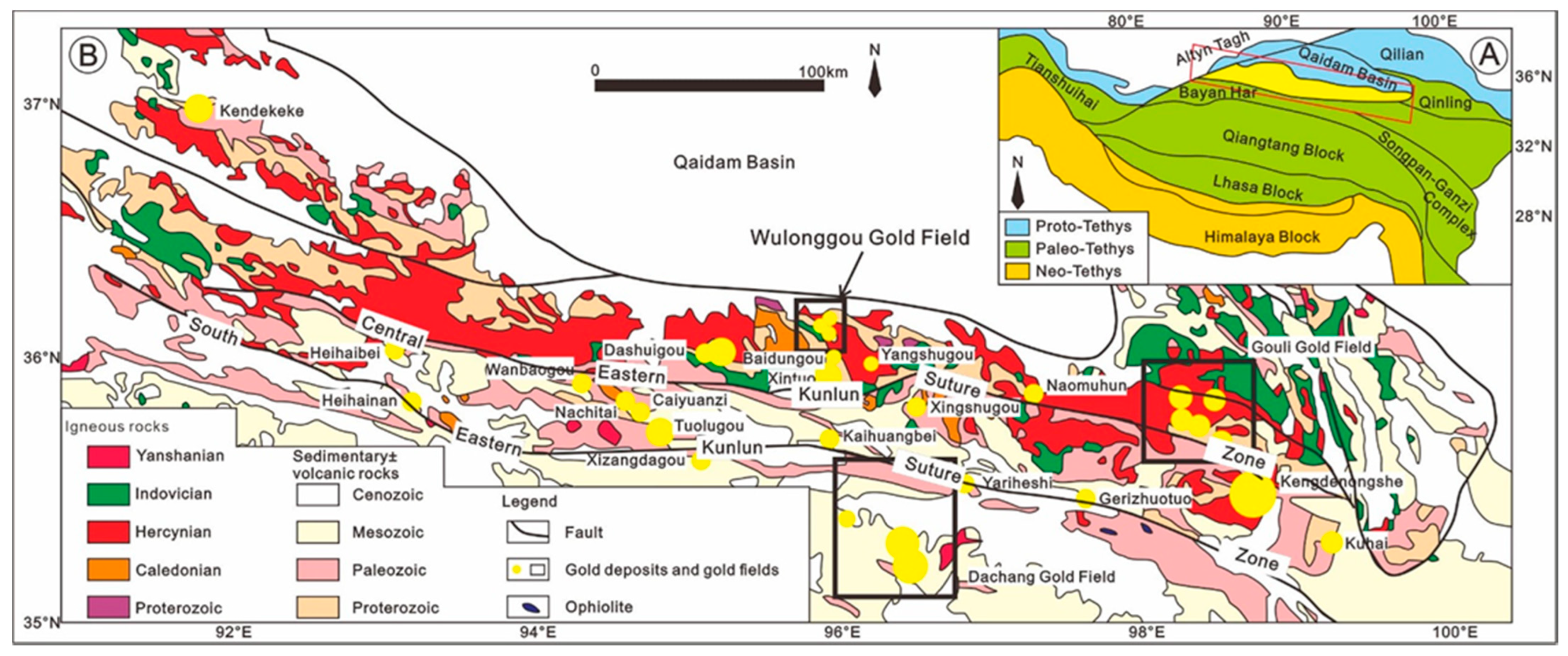
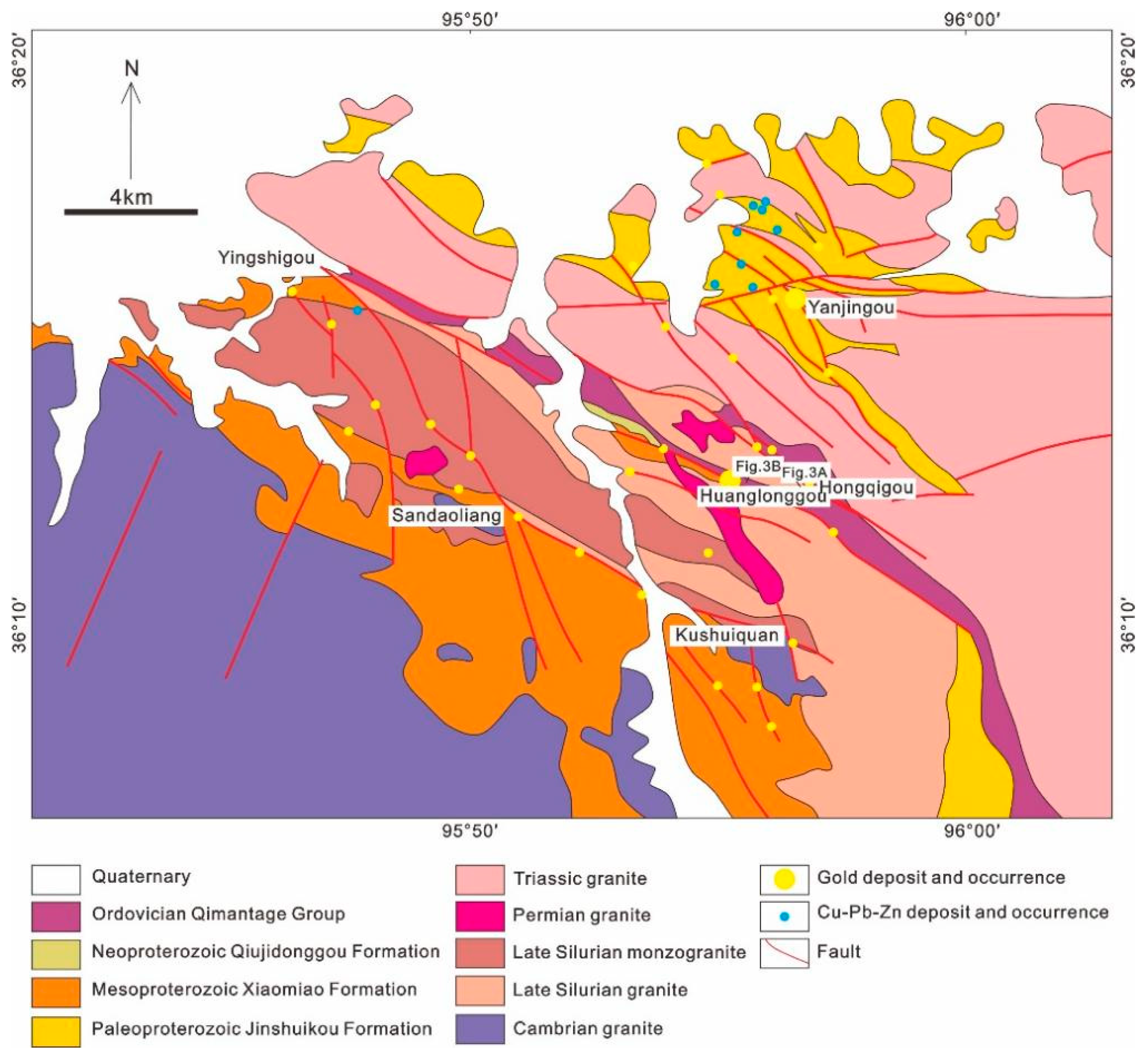
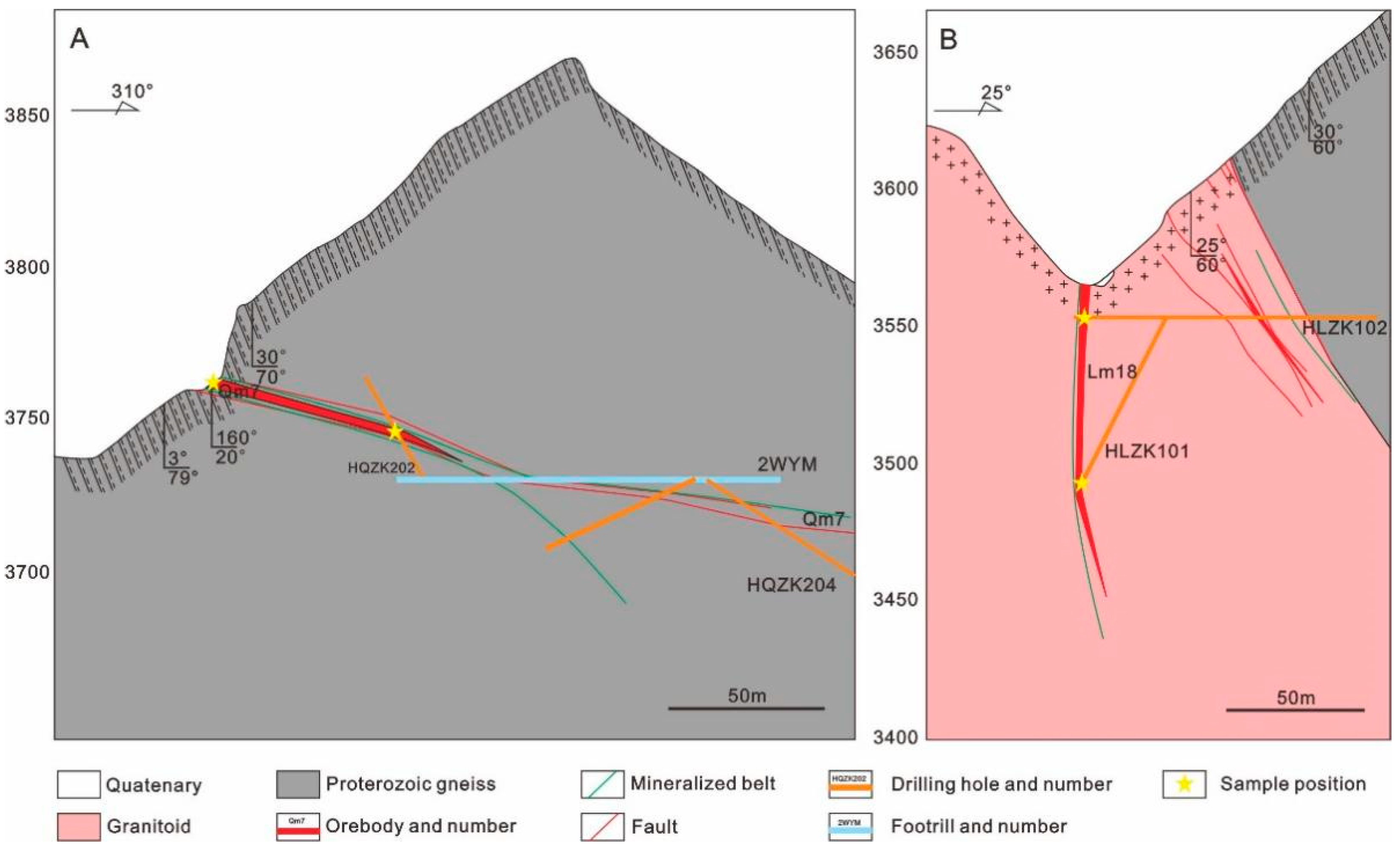
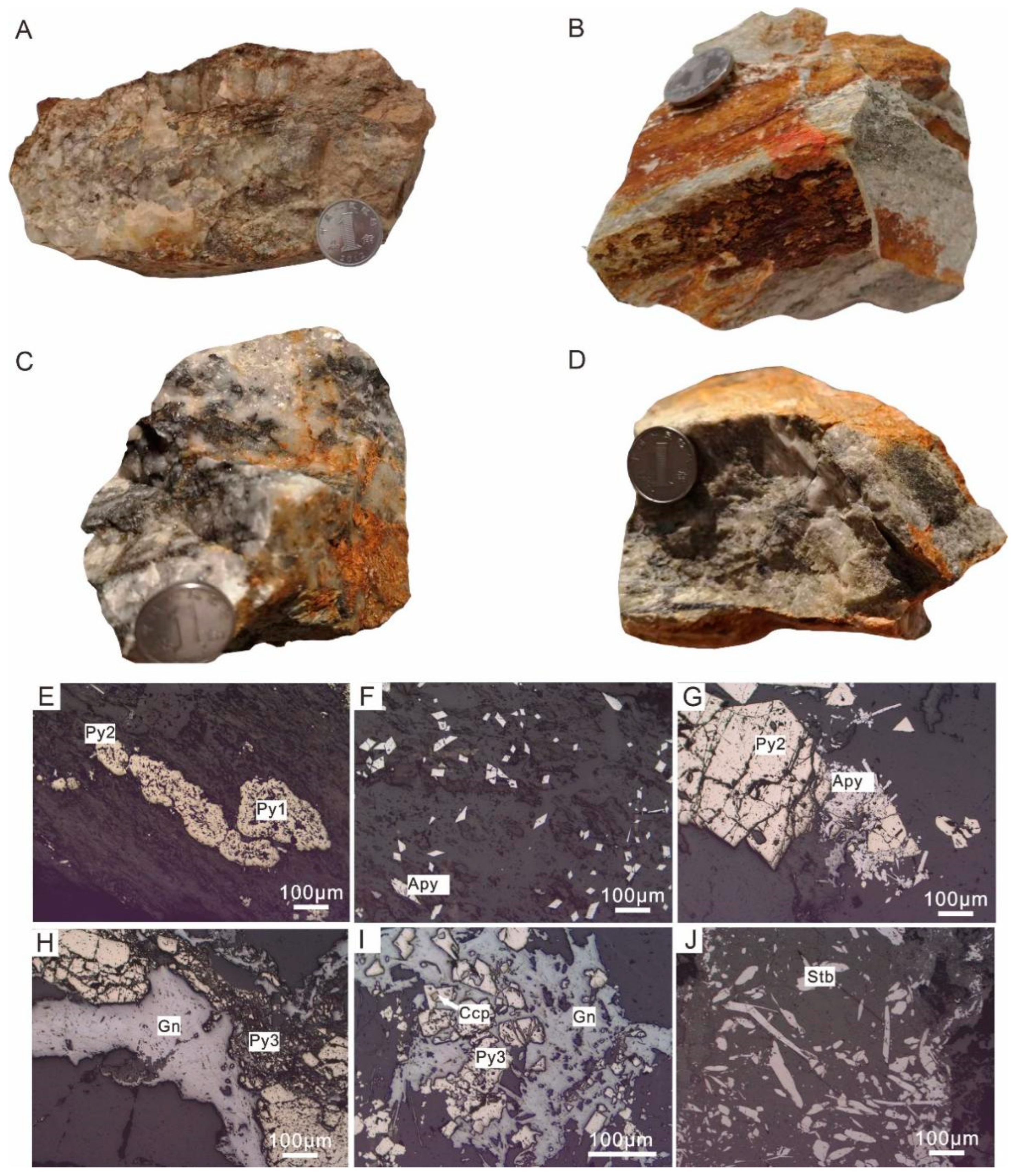
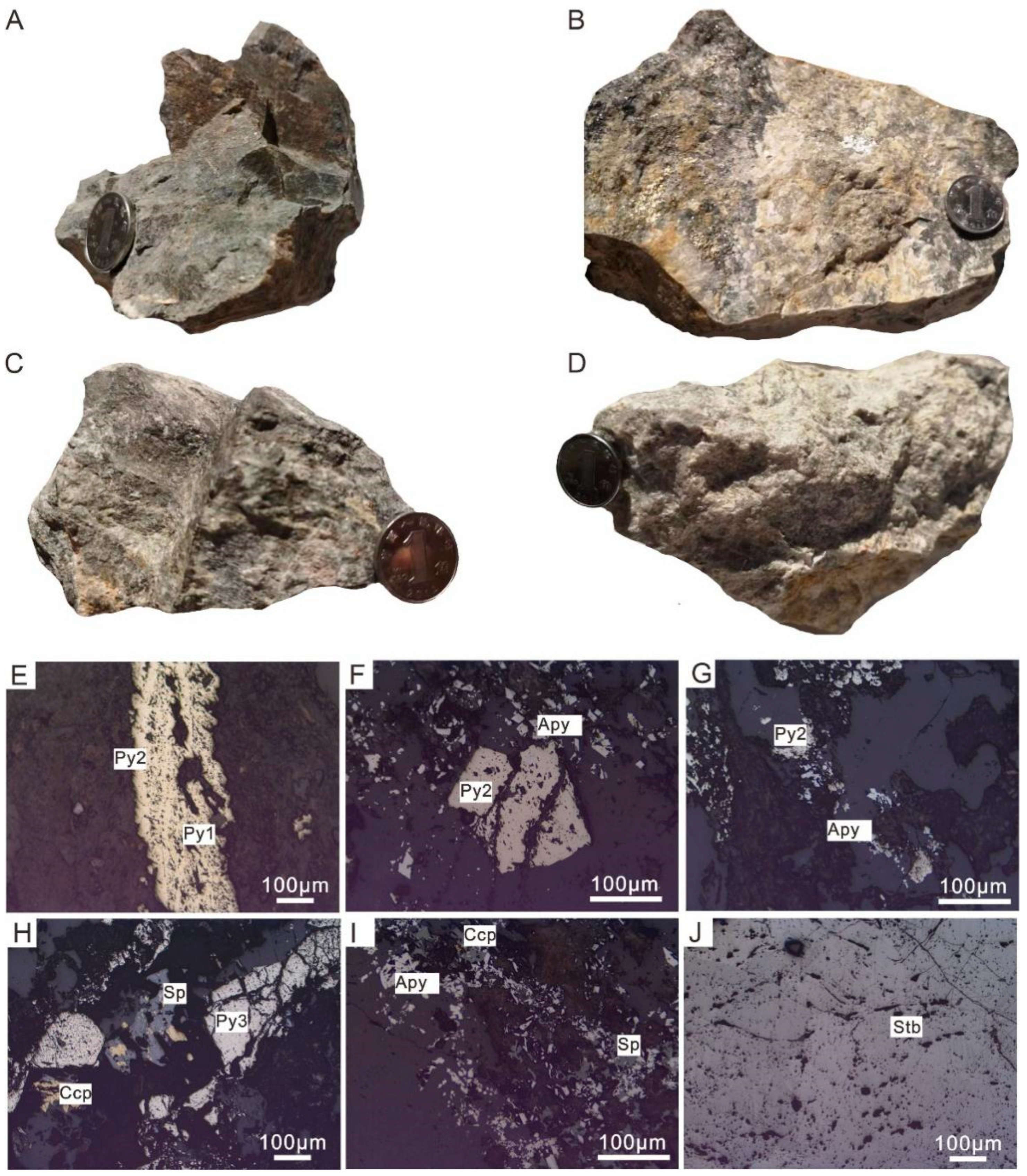
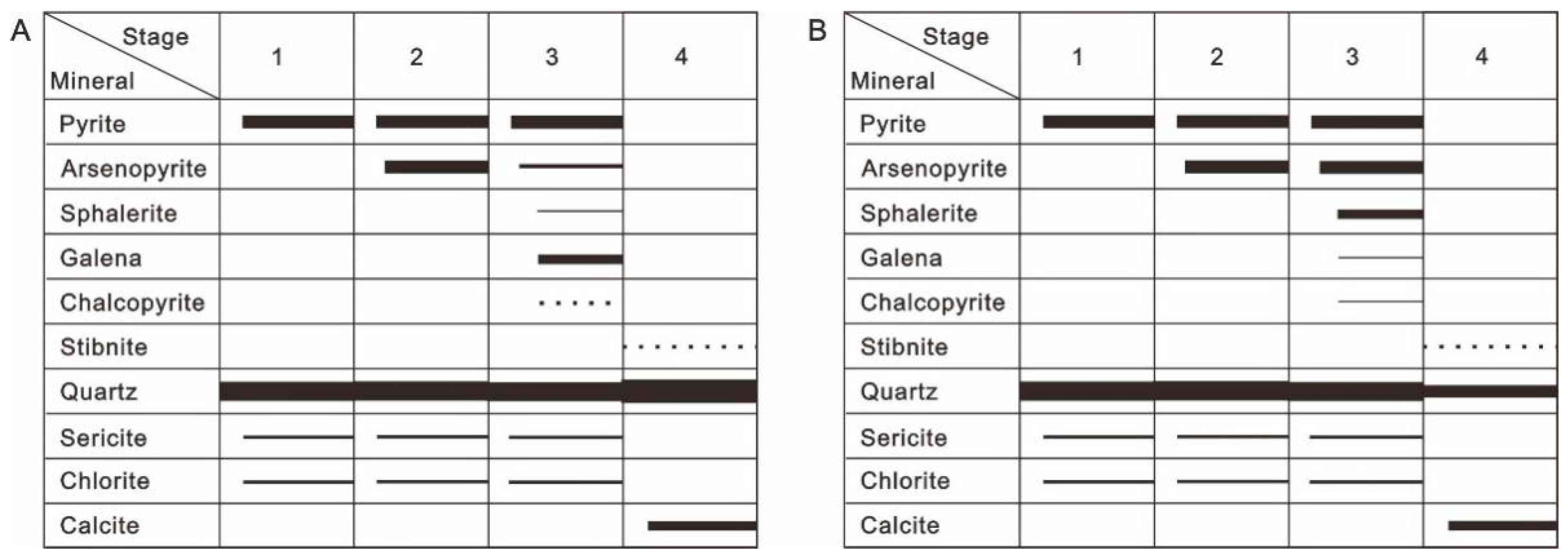
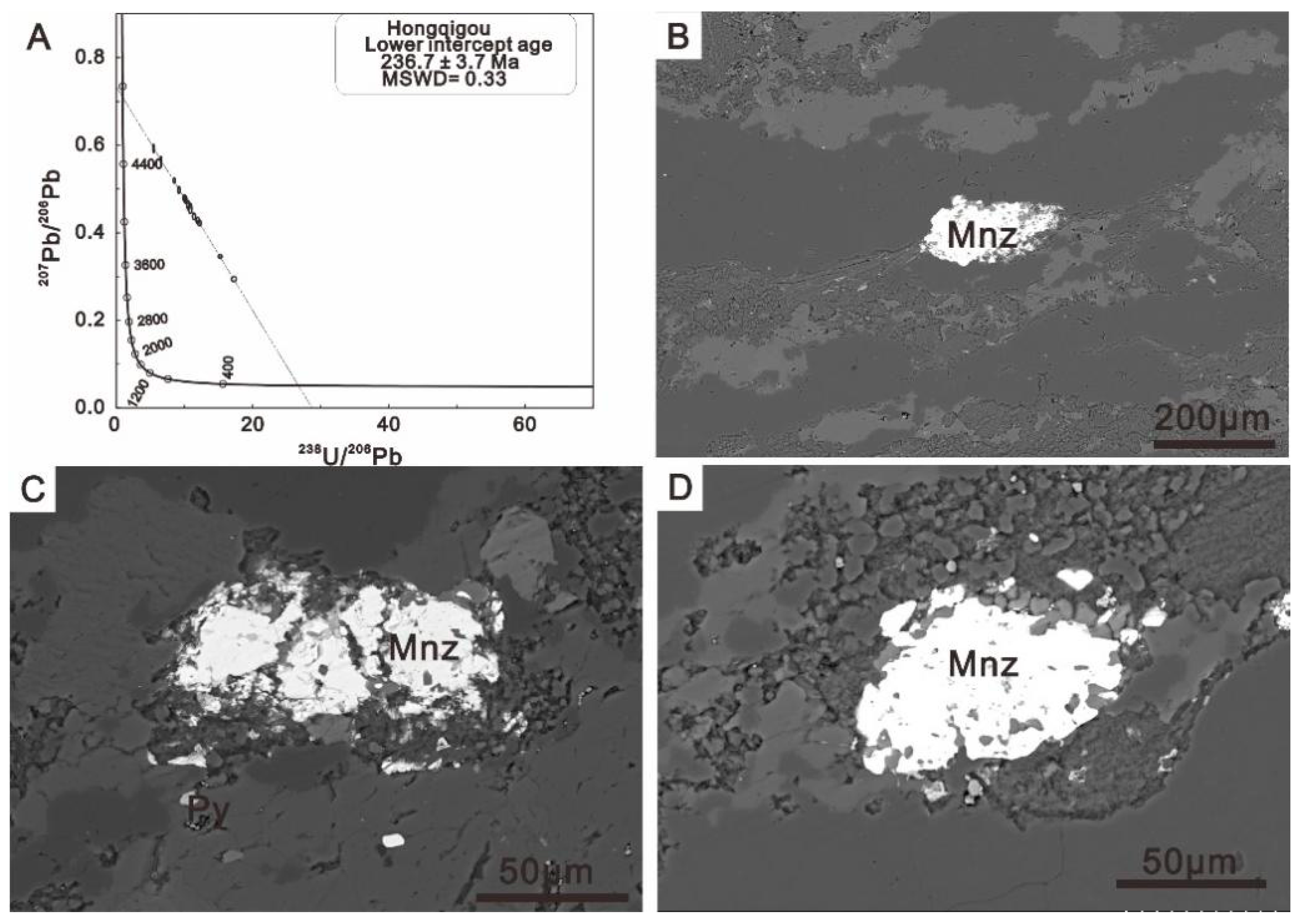
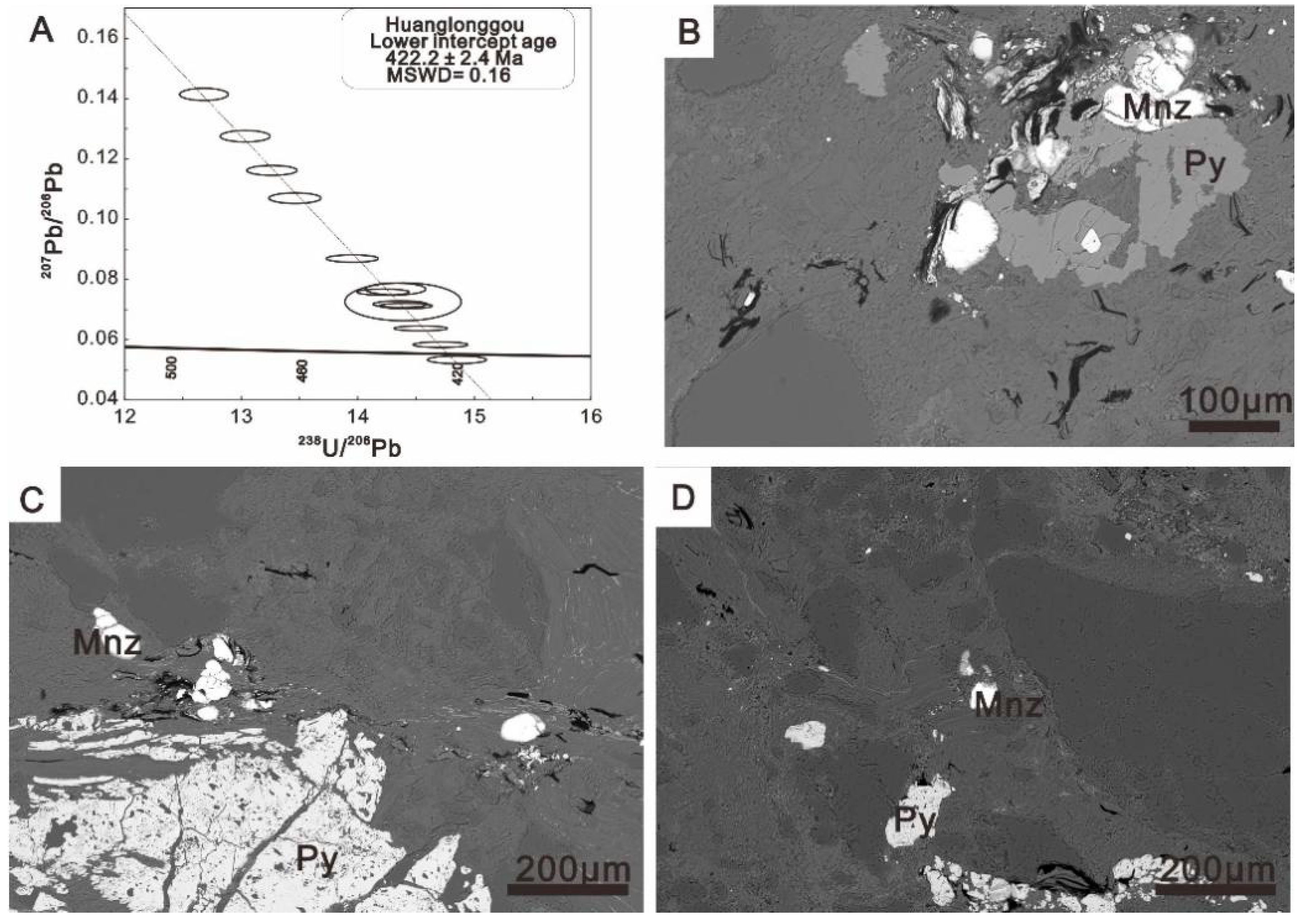
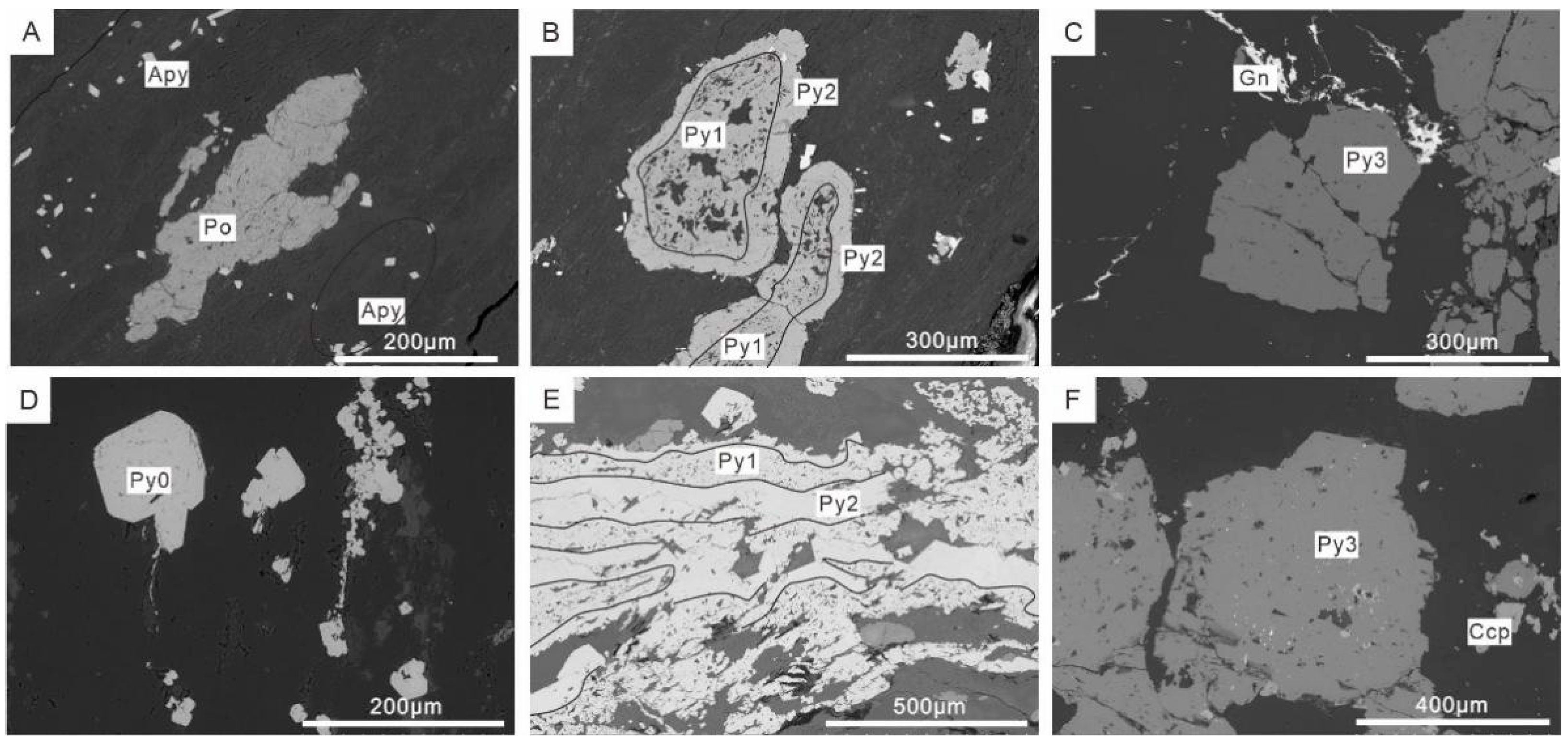
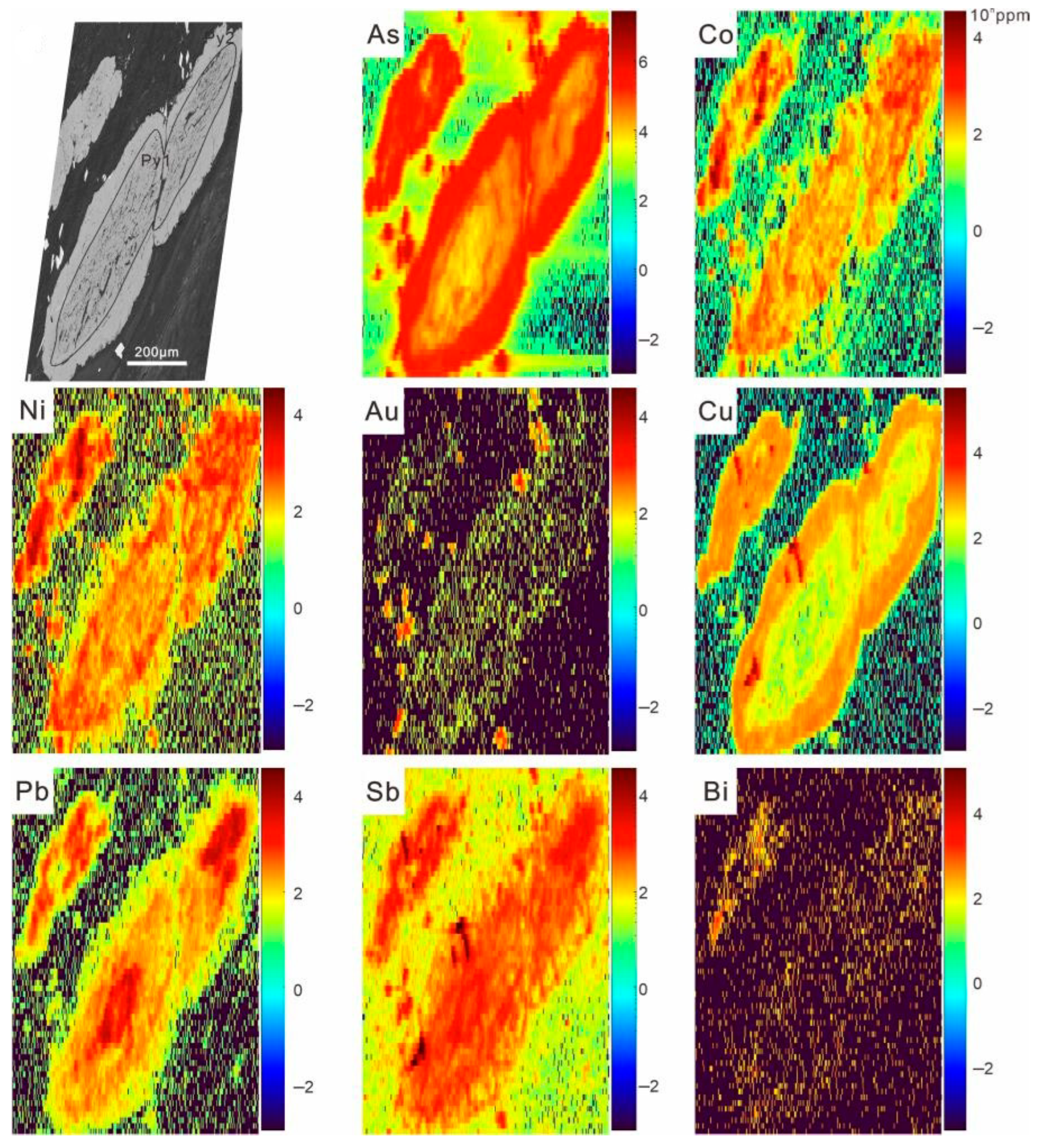
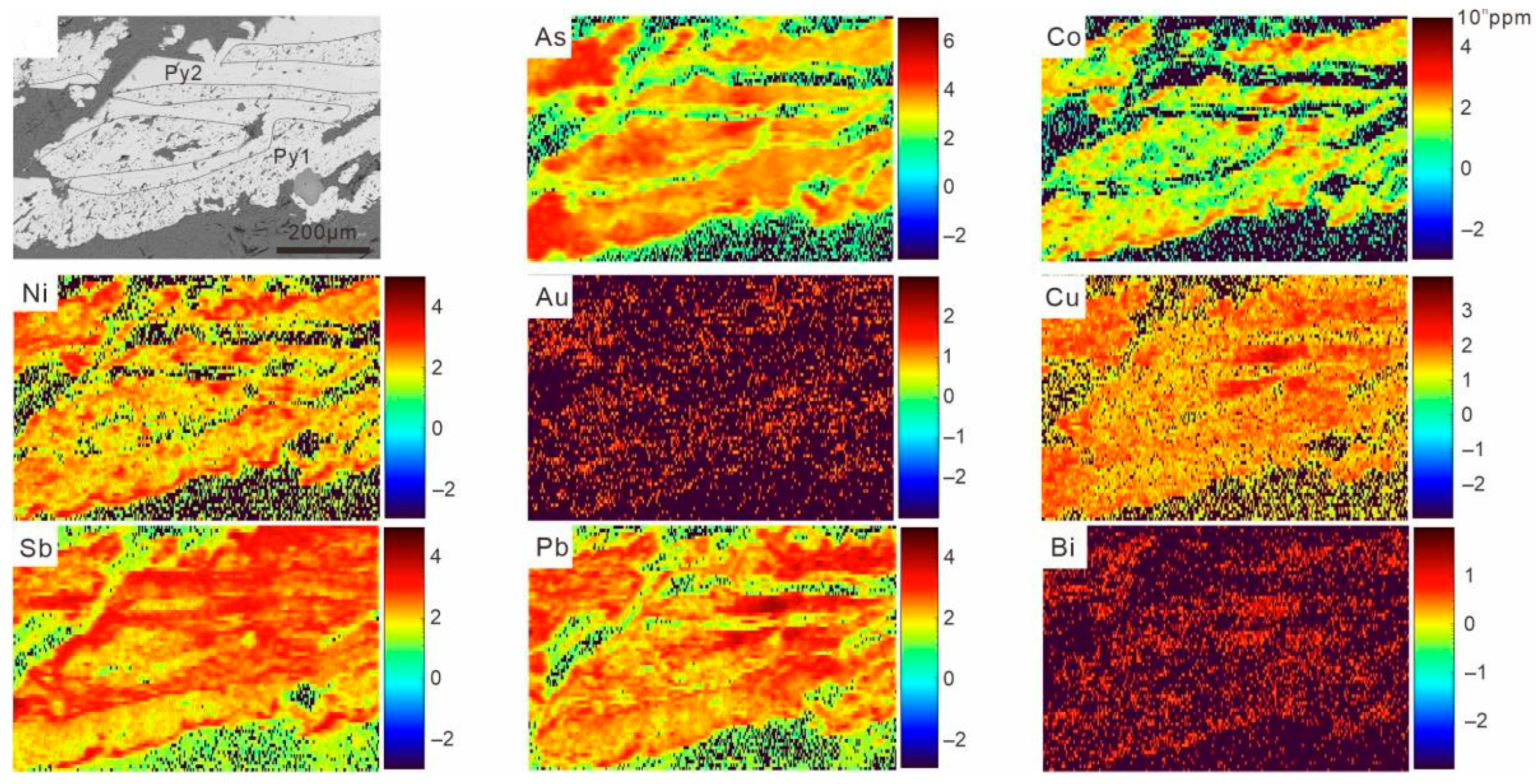
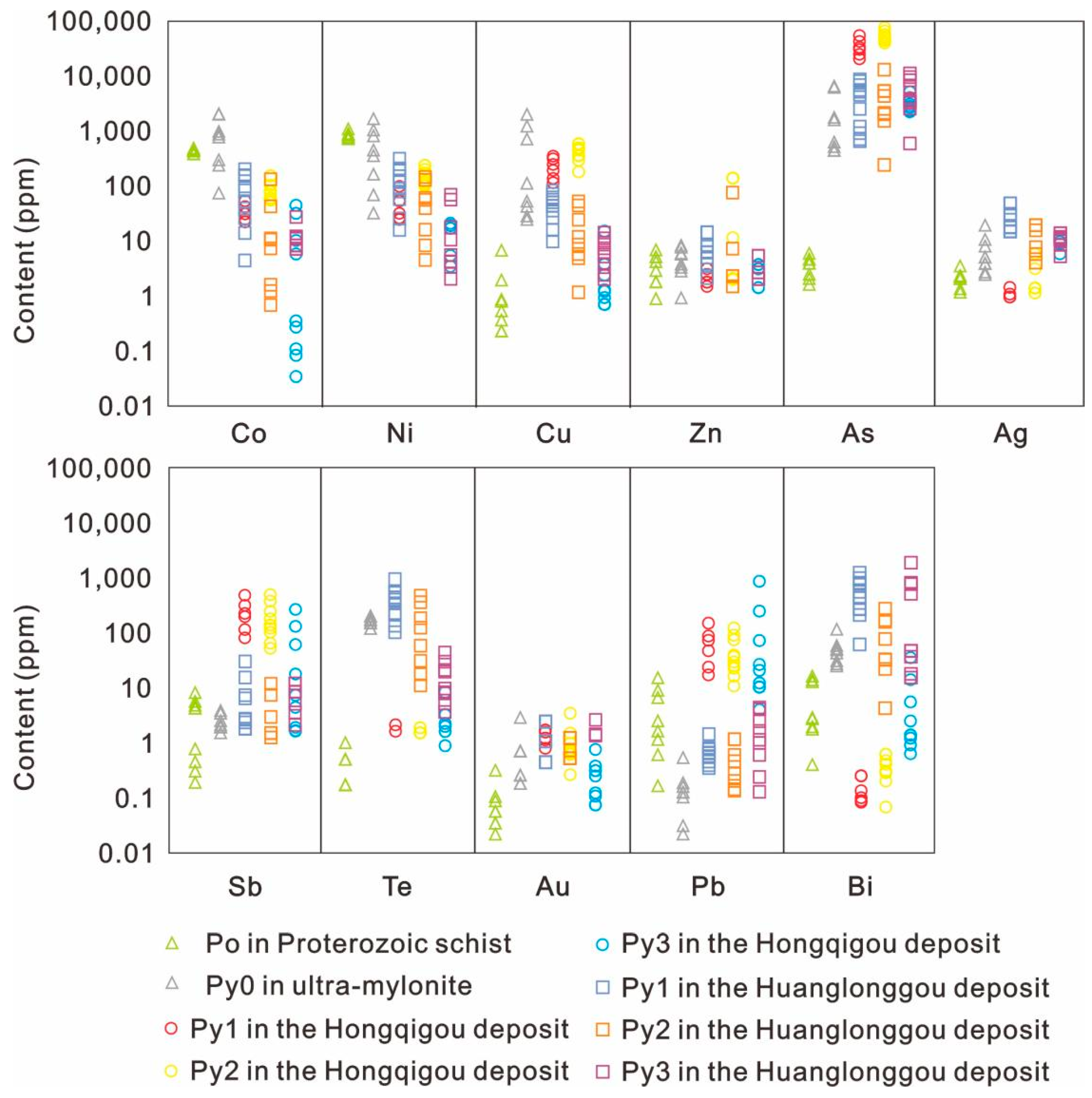
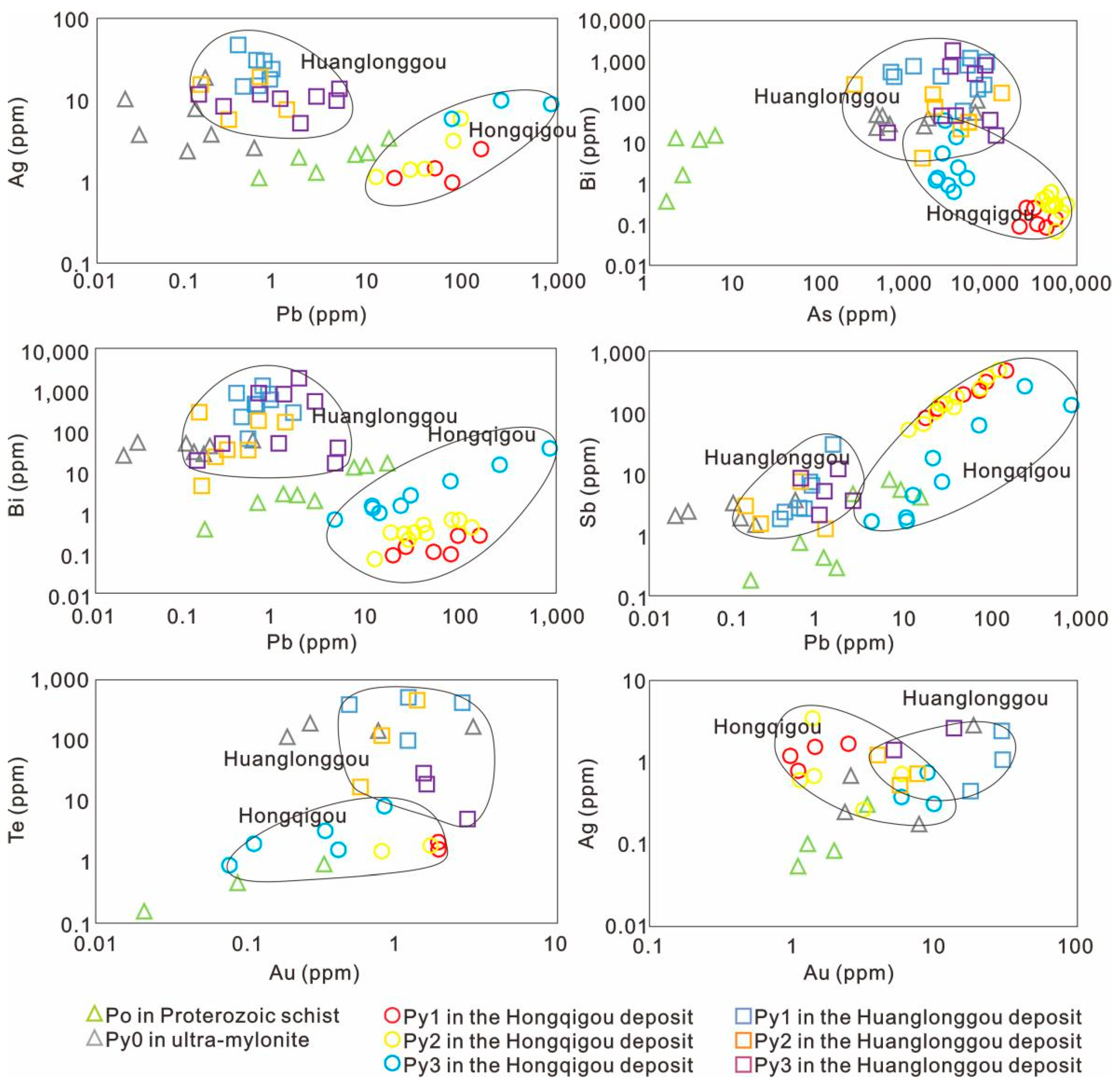
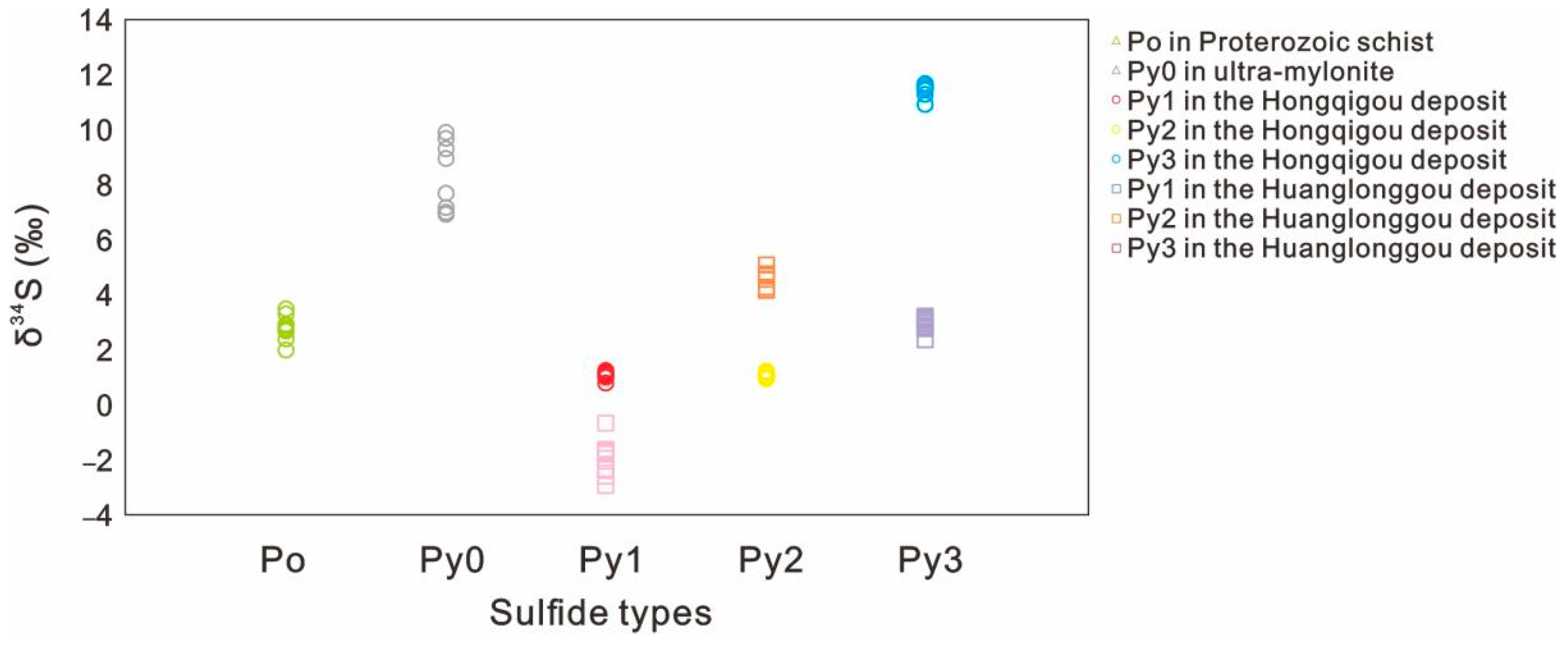
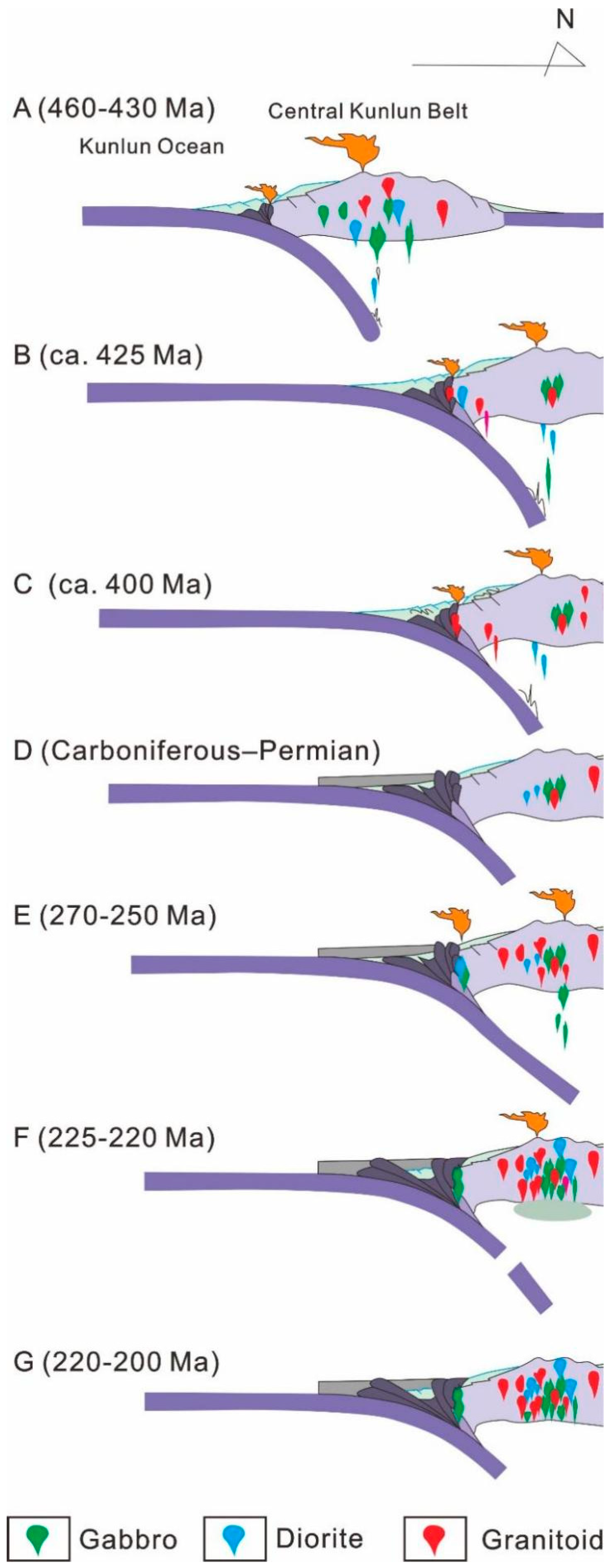
| Hongqigou Deposit | ||||||||
|---|---|---|---|---|---|---|---|---|
| Spot Number | 207Pb/206Pb | Error | 206Pb/238U | Error | 207Pb/235U | Error | 208Pb/232Th | Error |
| Hongqigou-1 | 0.42256 | 0.00545 | 0.08213 | 0.00126 | 4.79008 | 0.04848 | 0.0183 | 0.00025 |
| Hongqigou-2 | 0.5193 | 0.00466 | 0.11783 | 0.00164 | 8.44495 | 0.06124 | 0.01918 | 0.00026 |
| Hongqigou-3 | 0.47555 | 0.0068 | 0.09846 | 0.0016 | 6.46213 | 0.07121 | 0.01847 | 0.00026 |
| Hongqigou-4 | 0.47919 | 0.00611 | 0.10034 | 0.00155 | 6.63648 | 0.0658 | 0.01921 | 0.00027 |
| Hongqigou-5 | 0.49759 | 0.00637 | 0.10905 | 0.0017 | 7.48896 | 0.07435 | 0.01864 | 0.00026 |
| Hongqigou-6 | 0.34584 | 0.00356 | 0.06569 | 0.00093 | 3.13573 | 0.02615 | 0.01761 | 0.00024 |
| Hongqigou-7 | 0.4282 | 0.0058 | 0.08395 | 0.00132 | 4.96137 | 0.05246 | 0.01814 | 0.00025 |
| Hongqigou-8 | 0.46357 | 0.00766 | 0.09491 | 0.00164 | 6.07223 | 0.07702 | 0.01658 | 0.00024 |
| Hongqigou-9 | 0.29419 | 0.0048 | 0.05799 | 0.00095 | 2.35443 | 0.03106 | 0.01898 | 0.00027 |
| Hongqigou-10 | 0.45555 | 0.00944 | 0.0924 | 0.00181 | 5.80953 | 0.09164 | 0.01667 | 0.00024 |
| Hongqigou-11 | 0.43754 | 0.00607 | 0.08783 | 0.00139 | 5.30415 | 0.05731 | 0.01682 | 0.00023 |
| Hongqigou-12 | 0.56724 | 0.00588 | 0.15324 | 0.00223 | 11.99711 | 0.09862 | 0.02323 | 0.00032 |
| Hongqigou-13 | 0.59236 | 0.00727 | 0.18292 | 0.00286 | 14.95476 | 0.14364 | 0.02494 | 0.00035 |
| Huanglonggou deposit | ||||||||
| Spot Number | 207Pb/206Pb | Error | 206Pb/238U | Error | 207Pb/235U | Error | 208Pb/232Th | Error |
| Huanglonggou-1 | 0.07582 | 0.00082 | 0.07033 | 0.00091 | 0.73646 | 0.00692 | 0.02172 | 0.00029 |
| Huanglonggou-2 | 0.11618 | 0.00135 | 0.07539 | 0.001 | 1.20969 | 0.01209 | 0.02214 | 0.0003 |
| Huanglonggou-3 | 0.05336 | 0.00105 | 0.06733 | 0.00094 | 0.49625 | 0.00913 | 0.02198 | 0.0003 |
| Huanglonggou-4 | 0.12753 | 0.00155 | 0.07672 | 0.00103 | 1.35138 | 0.01411 | 0.02182 | 0.00029 |
| Huanglonggou-5 | 0.08696 | 0.001 | 0.07166 | 0.00094 | 0.86071 | 0.00867 | 0.02251 | 0.0003 |
| Huanglonggou-6 | 0.07261 | 0.00514 | 0.0695 | 0.00197 | 0.69693 | 0.04652 | 0.01675 | 0.00023 |
| Huanglonggou-7 | 0.14143 | 0.00165 | 0.07886 | 0.00106 | 1.54043 | 0.01526 | 0.02374 | 0.00032 |
| Huanglonggou-8 | 0.07181 | 0.0009 | 0.06962 | 0.00092 | 0.6905 | 0.00773 | 0.02183 | 0.00029 |
| Huanglonggou-9 | 0.07122 | 0.00074 | 0.06938 | 0.0009 | 0.6825 | 0.00608 | 0.02181 | 0.00029 |
| Huanglonggou-10 | 0.06378 | 0.00067 | 0.06877 | 0.00089 | 0.60583 | 0.00554 | 0.02049 | 0.00027 |
| Huanglonggou-11 | 0.05834 | 0.00075 | 0.06798 | 0.00089 | 0.54775 | 0.00634 | 0.02032 | 0.00027 |
| Huanglonggou-12 | 0.07682 | 0.00161 | 0.06981 | 0.00103 | 0.74073 | 0.01423 | 0.02069 | 0.00029 |
| Huanglonggou-13 | 0.10698 | 0.00144 | 0.07428 | 0.00101 | 1.09761 | 0.01294 | 0.01785 | 0.00024 |
| 59Co | 60Ni | 65Cu | 66Zn | 75As | 107Ag | 121Sb | 125Te | 197Au | 208Pb | 209Bi | ||
|---|---|---|---|---|---|---|---|---|---|---|---|---|
| Pyrrhotite in schist (n = 8) | Min | 326.323 | 591.205 | bdl. | bdl. | bdl. | bdl. | 0.178 | bdl. | bdl. | 0.155 | 0.367 |
| Max | 491.131 | 1073.904 | 1.949 | 7.117 | 4.594 | 2.240 | 15.199 | 0.461 | 0.124 | 8.720 | 13.182 | |
| Median | 431.729 | 812.913 | 0.773 | 2.840 | 1.818 | 1.093 | 4.338 | 0.077 | 0.052 | 3.069 | 4.630 | |
| Pyrite in ultra-mylonite (n = 8) | Min | 73.199 | 30.788 | 25.344 | 0.937 | 455.063 | 2.355 | bdl. | 114.985 | bdl. | bdl. | 23.681 |
| Max | 2090.737 | 1663.032 | 2124.885 | 8.683 | 6884.256 | 18.771 | 3.657 | 196.658 | 2.841 | 0.512 | 110.829 | |
| Median | 925.406 | 566.395 | 554.571 | 5.002 | 2371.613 | 6.766 | 1.829 | 155.343 | 0.494 | 0.138 | 47.744 | |
| Py1 in Hongqigou (n = 6) | Min | 23.159 | 25.736 | 119.957 | bdl. | 21,440.451 | bdl. | 80.295 | bdl. | 0.790 | 17.017 | 0.084 |
| Max | 55.921 | 103.544 | 360.547 | 3.328 | 56,807.293 | 2.491 | 480.888 | 2.123 | 1.691 | 148.769 | 0.256 | |
| Median | 34.156 | 50.335 | 234.019 | 1.568 | 35,862.411 | 1.004 | 234.779 | 0.623 | 1.337 | 65.914 | 0.154 | |
| Py2 in Hongqigou (n = 10) | Min | 57.332 | 102.625 | 185.494 | bdl. | 40,115.177 | bdl. | 51.747 | bdl. | 0.263 | 10.809 | 0.068 |
| Max | 159.267 | 242.640 | 607.798 | 146.296 | 76,993.084 | 5.901 | 491.204 | 1.869 | 3.447 | 121.852 | 0.621 | |
| Median | 90.756 | 157.615 | 423.802 | 16.280 | 54,278.866 | 1.303 | 189.854 | 0.338 | 1.023 | 46.533 | 0.358 | |
| Py3 in Hongqigou (n = 9) | Min | 0.036 | bdl. | 0.737 | bdl. | 2262.859 | bdl. | 1.632 | bdl. | bdl. | 3.974 | 0.638 |
| Max | 46.389 | 21.510 | 15.724 | 3.974 | 5223.606 | 9.880 | 265.700 | 8.308 | 0.751 | 857.226 | 35.190 | |
| Median | 10.758 | 7.550 | 3.483 | 0.981 | 3363.130 | 2.742 | 54.684 | 2.031 | 0.221 | 139.826 | 6.971 | |
| Py1 in Huanglonggou (n = 10) | Min | 14.371 | 16.091 | 10.330 | bdl. | 671.534 | bdl. | bdl. | 99.793 | bdl. | bdl. | 60.713 |
| Max | 203.787 | 313.391 | 86.059 | 15.131 | 8871.994 | 47.119 | 29.734 | 916.985 | 2.416 | 1.414 | 1210.961 | |
| Median | 88.777 | 136.476 | 46.229 | 5.476 | 4503.607 | 20.885 | 5.286 | 366.128 | 0.501 | 0.592 | 568.107 | |
| Py2 in Huanglonggou (n = 8) | Min | 0.707 | 4.625 | 1.232 | bdl. | 250.834 | bdl. | bdl. | 10.803 | bdl. | bdl. | 4.263 |
| Max | 135.063 | 147.200 | 54.534 | 79.576 | 13,275.196 | 19.131 | 11.649 | 460.266 | 1.229 | 0.592 | 269.836 | |
| Median | 26.475 | 58.107 | 20.032 | 11.410 | 4338.190 | 6.487 | 3.080 | 152.824 | 0.310 | 0.369 | 95.117 | |
| Py3 in Huanglonggou (n = 9) | Min | 7.310 | 2.107 | 2.135 | bdl. | 612.995 | bdl. | bdl. | 3.573 | bdl. | 0.128 | 15.335 |
| Max | 27.731 | 69.971 | 14.968 | 5.692 | 11,409.009 | 13.659 | 11.823 | 42.921 | 2.615 | 4.304 | 1853.086 | |
| Median | 11.855 | 19.506 | 7.214 | 1.188 | 5566.746 | 9.096 | 3.438 | 16.193 | 0.599 | 1.714 | 452.719 |
| Sample Name | δ34Sv-CDT (‰) | Delta-2SE | Sample Name | δ34Sv-CDT (‰) | Delta-2SE |
|---|---|---|---|---|---|
| Schist-Po-1 | 9.30 | 0.08 | Hongqigou-Py3-3 | 11.52 | 0.10 |
| Schist-Po-2 | 8.95 | 0.11 | Hongqigou-Py3-4 | 11.66 | 0.09 |
| Schist-Po-3 | 7.16 | 0.09 | Hongqigou-Py3-5 | 11.61 | 0.10 |
| Schist-Po-4 | 7.00 | 0.08 | Hongqigou-Py3-6 | 10.91 | 0.09 |
| Schist-Po-5 | 6.92 | 0.10 | Hongqigou-Py3-7 | 11.48 | 0.09 |
| Schist-Po-6 | 9.90 | 0.09 | Hongqigou-Py3-8 | 11.54 | 0.10 |
| Schist-Po-7 | 7.68 | 0.10 | Hongqigou-Py3-9 | 11.28 | 0.11 |
| Schist-Po-8 | 9.67 | 0.08 | Huanglonggou-Py1-1 | −1.63 | 0.10 |
| Ultramylonite-Py-1 | 2.70 | 0.22 | Huanglonggou-Py1-2 | −2.94 | 0.11 |
| Ultramylonite-Py-2 | 2.92 | 0.19 | Huanglonggou-Py1-3 | −1.65 | 0.09 |
| Ultramylonite-Py-3 | 2.39 | 0.27 | Huanglonggou-Py1-4 | −1.78 | 0.11 |
| Ultramylonite-Py-4 | 3.30 | 0.20 | Huanglonggou-Py1-5 | −1.95 | 0.11 |
| Ultramylonite-Py-5 | 3.48 | 0.19 | Huanglonggou-Py1-6 | −2.61 | 0.10 |
| Ultramylonite-Py-6 | 2.78 | 0.20 | Huanglonggou-Py1-7 | −1.72 | 0.09 |
| Ultramylonite-Py-7 | 2.68 | 0.17 | Huanglonggou-Py1-8 | −2.35 | 0.12 |
| Ultramylonite-Py-8 | 2.87 | 0.16 | Huanglonggou-Py1-9 | −2.34 | 0.10 |
| Hongqigou-Py1-1 | 1.07 | 0.10 | Huanglonggou-Py1-10 | −0.68 | 0.21 |
| Hongqigou-Py1-2 | 1.09 | 0.09 | Huanglonggou-Py2-1 | 4.00 | 0.09 |
| Hongqigou-Py1-3 | 1.13 | 0.09 | Huanglonggou-Py2-2 | 4.74 | 0.09 |
| Hongqigou-Py1-4 | 1.19 | 0.10 | Huanglonggou-Py2-3 | 4.67 | 0.07 |
| Hongqigou-Py1-5 | 1.00 | 0.08 | Huanglonggou-Py2-4 | 4.55 | 0.08 |
| Hongqigou-Py1-6 | 1.01 | 0.09 | Huanglonggou-Py2-5 | 4.15 | 0.08 |
| Hongqigou-Py2-1 | 1.16 | 0.09 | Huanglonggou-Py2-6 | 4.70 | 0.08 |
| Hongqigou-Py2-2 | 1.17 | 0.08 | Huanglonggou-Py2-7 | 4.17 | 0.08 |
| Hongqigou-Py2-3 | 1.02 | 0.07 | Huanglonggou-Py2-8 | 4.26 | 0.08 |
| Hongqigou-Py2-4 | 0.95 | 0.08 | Huanglonggou-Py3-1 | 3.12 | 0.08 |
| Hongqigou-Py2-5 | 1.08 | 0.09 | Huanglonggou-Py3-2 | 3.14 | 0.10 |
| Hongqigou-Py2-6 | 1.22 | 0.09 | Huanglonggou-Py3-3 | 3.06 | 0.11 |
| Hongqigou-Py2-7 | 1.15 | 0.10 | Huanglonggou-Py3-4 | 2.75 | 0.10 |
| Hongqigou-Py2-8 | 1.20 | 0.08 | Huanglonggou-Py3-5 | 3.63 | 0.11 |
| Hongqigou-Py2-9 | 0.98 | 0.09 | Huanglonggou-Py3-6 | 2.97 | 0.10 |
| Hongqigou-Py2-10 | 1.15 | 0.08 | Huanglonggou-Py3-7 | 2.81 | 0.12 |
| Hongqigou-Py3-1 | 11.62 | 0.09 | Huanglonggou-Py3-8 | 3.21 | 0.11 |
| Hongqigou-Py3-2 | 11.43 | 0.10 | Huanglonggou-Py3-9 | 2.89 | 0.09 |
| Gold Deposit | Sample | Mineral for Age Determination and Method | Age (Ma) | Reference |
|---|---|---|---|---|
| Annage | Pyrite | Pyrite Re–Os | 383 ± 8 | [100] |
| Asiha | Ore | Monazite U–Pb | 227.1 ± 6.5 | [101] |
| Asiha | Granite porphyry | Zircon U–Pb | 1 | [101] |
| Caiyuanzi | Granodiorite porphyry | Zircon U–Pb | 210.4 ± 1.9 | [102] |
| Dashuigou | Tonalite | Zircon U–Pb | 239.5 ± 0.9 | [103] |
| Gerizhuotuo | Granodiorite | Zircon U–Pb | 213.25 ± 0.62 | [86] |
| Guoluolongwa | Pyrite and chalcopyrite | Sulfide Re–Os | 374 ± 15 | [100] |
| Baidungou | Quartz diorite | Zircon U–Pb | 241.08 ± 0.90 | [3] |
| Hongqigou | Dolerite | Zircon U–Pb | 242.8 ± 2.1 | [104] |
| Heishigou | Dolerite | Zircon U–Pb | 244.1 ± 1.6 | [3] |
| Kendekeke | Dacite tuffs | Zircon U–Pb | 227.1 ± 1.2 | [87] |
| Kendekeke | Monzogranite | Zircon U–Pb | 229.5 ± 0.5 | [88] |
| Kendekeke | Monzogranite | Zircon U–Pb | 230.5 ± 4.2 | [89] |
| Kengdenongshe | Ore-bearing rhyolitic tuffs | Zircon U–Pb | 243.3 ± 1.6 | [90] |
| Naomuhun | Sericite | Sericite Ar–Ar | 227.84 ± 1.13 | [91] |
| Naomuhun | Quartz diorite | Zircon U–Pb | 235.8 ± 0.8 | [91] |
| Xingshugou | Quartz albite porphyry | Zircon U–Pb | 243.4 ± 1.9 | [105] |
| Yanjingou | Ore | Quartz inclusion Rb–Sr | 237 ± 3 | [4] |
| Tuolugou | Pyrite | Pyrite Re–Os | 429 ± 29 | [106] |
Publisher’s Note: MDPI stays neutral with regard to jurisdictional claims in published maps and institutional affiliations. |
© 2022 by the authors. Licensee MDPI, Basel, Switzerland. This article is an open access article distributed under the terms and conditions of the Creative Commons Attribution (CC BY) license (https://creativecommons.org/licenses/by/4.0/).
Share and Cite
Zhang, Z.; Zeng, Q.; Pan, T.; Xie, H.; Wei, Z.; Fan, H.; Wu, J.; Yang, K.; Li, X.; Liang, G. Two Epochs of Mineralization of Orogenic Gold Deposit in the East Kunlun Orogenic Belt: Constraints from Monazite U–Pb Age, In Situ Sulfide Trace Elements and Sulfur Isotopes in Wulonggou Gold Field. Minerals 2022, 12, 968. https://doi.org/10.3390/min12080968
Zhang Z, Zeng Q, Pan T, Xie H, Wei Z, Fan H, Wu J, Yang K, Li X, Liang G. Two Epochs of Mineralization of Orogenic Gold Deposit in the East Kunlun Orogenic Belt: Constraints from Monazite U–Pb Age, In Situ Sulfide Trace Elements and Sulfur Isotopes in Wulonggou Gold Field. Minerals. 2022; 12(8):968. https://doi.org/10.3390/min12080968
Chicago/Turabian StyleZhang, Zheming, Qingdong Zeng, Tong Pan, Hailin Xie, Zhanhao Wei, Hongrui Fan, Jinjian Wu, Kuifeng Yang, Xinghui Li, and Gaizhong Liang. 2022. "Two Epochs of Mineralization of Orogenic Gold Deposit in the East Kunlun Orogenic Belt: Constraints from Monazite U–Pb Age, In Situ Sulfide Trace Elements and Sulfur Isotopes in Wulonggou Gold Field" Minerals 12, no. 8: 968. https://doi.org/10.3390/min12080968
APA StyleZhang, Z., Zeng, Q., Pan, T., Xie, H., Wei, Z., Fan, H., Wu, J., Yang, K., Li, X., & Liang, G. (2022). Two Epochs of Mineralization of Orogenic Gold Deposit in the East Kunlun Orogenic Belt: Constraints from Monazite U–Pb Age, In Situ Sulfide Trace Elements and Sulfur Isotopes in Wulonggou Gold Field. Minerals, 12(8), 968. https://doi.org/10.3390/min12080968








